Australian Dollar Inflation and Deflation
VerifiedAdded on 2023/06/14
|32
|7593
|326
AI Summary
This paper discusses the history and background of inflation and deflation of the Australian dollar, its literature review, research and analysis, and household survey. It also compares the Australian dollar to the Bangladesh taka(BDT) by analyzing their historical inflation and deflation data.
Contribute Materials
Your contribution can guide someone’s learning journey. Share your
documents today.

Secure Best Marks with AI Grader
Need help grading? Try our AI Grader for instant feedback on your assignments.
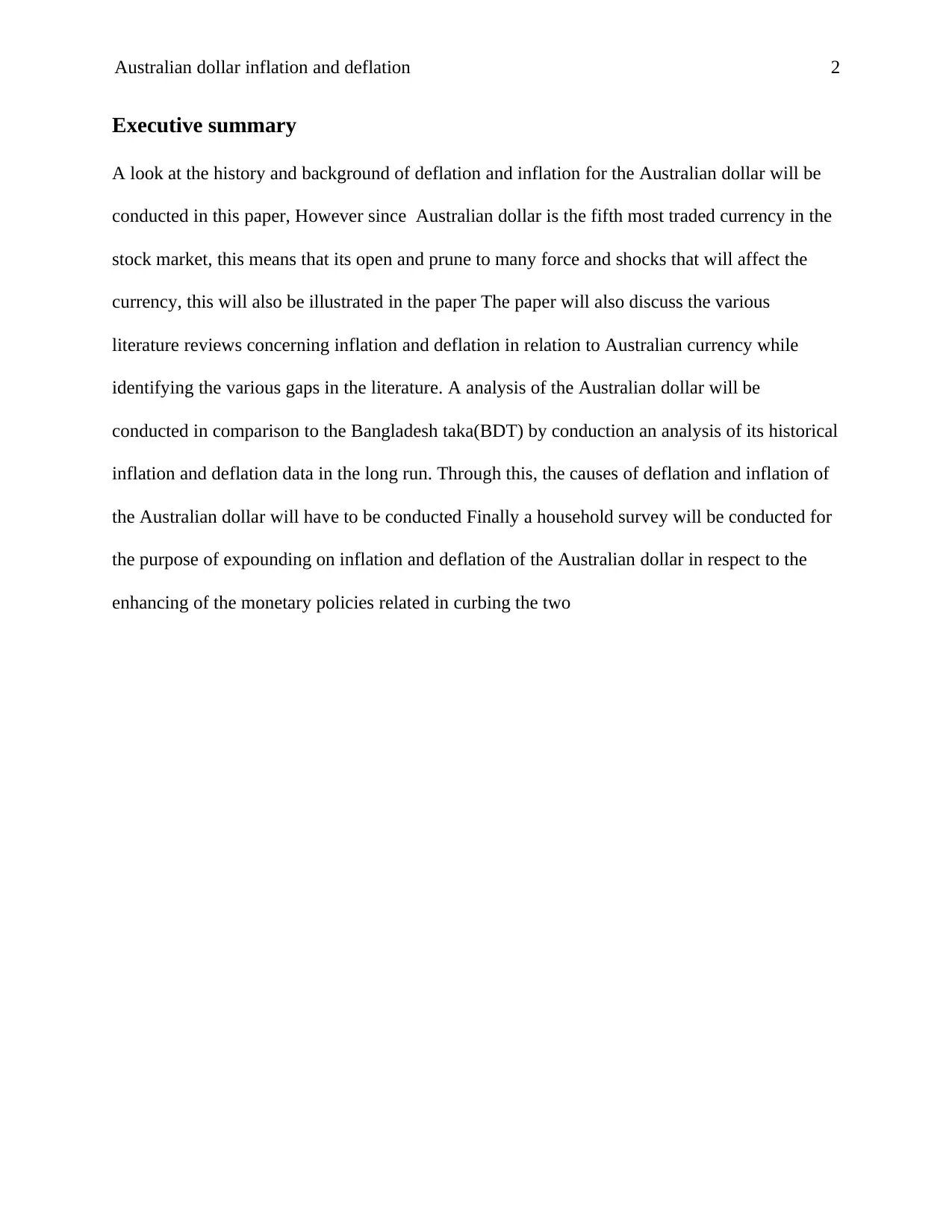
Australian dollar inflation and deflation 2
Executive summary
A look at the history and background of deflation and inflation for the Australian dollar will be
conducted in this paper, However since Australian dollar is the fifth most traded currency in the
stock market, this means that its open and prune to many force and shocks that will affect the
currency, this will also be illustrated in the paper The paper will also discuss the various
literature reviews concerning inflation and deflation in relation to Australian currency while
identifying the various gaps in the literature. A analysis of the Australian dollar will be
conducted in comparison to the Bangladesh taka(BDT) by conduction an analysis of its historical
inflation and deflation data in the long run. Through this, the causes of deflation and inflation of
the Australian dollar will have to be conducted Finally a household survey will be conducted for
the purpose of expounding on inflation and deflation of the Australian dollar in respect to the
enhancing of the monetary policies related in curbing the two
Executive summary
A look at the history and background of deflation and inflation for the Australian dollar will be
conducted in this paper, However since Australian dollar is the fifth most traded currency in the
stock market, this means that its open and prune to many force and shocks that will affect the
currency, this will also be illustrated in the paper The paper will also discuss the various
literature reviews concerning inflation and deflation in relation to Australian currency while
identifying the various gaps in the literature. A analysis of the Australian dollar will be
conducted in comparison to the Bangladesh taka(BDT) by conduction an analysis of its historical
inflation and deflation data in the long run. Through this, the causes of deflation and inflation of
the Australian dollar will have to be conducted Finally a household survey will be conducted for
the purpose of expounding on inflation and deflation of the Australian dollar in respect to the
enhancing of the monetary policies related in curbing the two
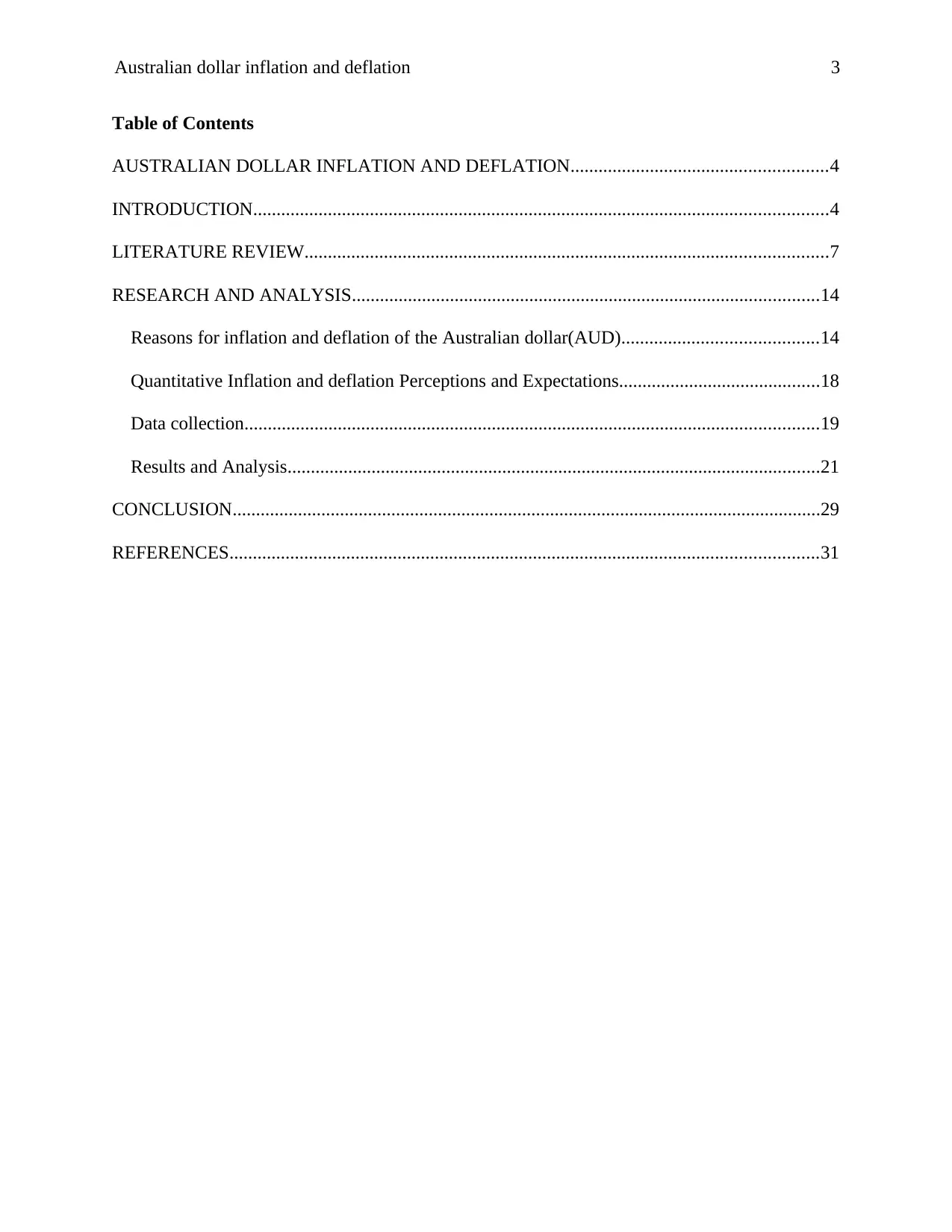
Australian dollar inflation and deflation 3
Table of Contents
AUSTRALIAN DOLLAR INFLATION AND DEFLATION.......................................................4
INTRODUCTION...........................................................................................................................4
LITERATURE REVIEW................................................................................................................7
RESEARCH AND ANALYSIS....................................................................................................14
Reasons for inflation and deflation of the Australian dollar(AUD)..........................................14
Quantitative Inflation and deflation Perceptions and Expectations...........................................18
Data collection...........................................................................................................................19
Results and Analysis..................................................................................................................21
CONCLUSION..............................................................................................................................29
REFERENCES..............................................................................................................................31
Table of Contents
AUSTRALIAN DOLLAR INFLATION AND DEFLATION.......................................................4
INTRODUCTION...........................................................................................................................4
LITERATURE REVIEW................................................................................................................7
RESEARCH AND ANALYSIS....................................................................................................14
Reasons for inflation and deflation of the Australian dollar(AUD)..........................................14
Quantitative Inflation and deflation Perceptions and Expectations...........................................18
Data collection...........................................................................................................................19
Results and Analysis..................................................................................................................21
CONCLUSION..............................................................................................................................29
REFERENCES..............................................................................................................................31
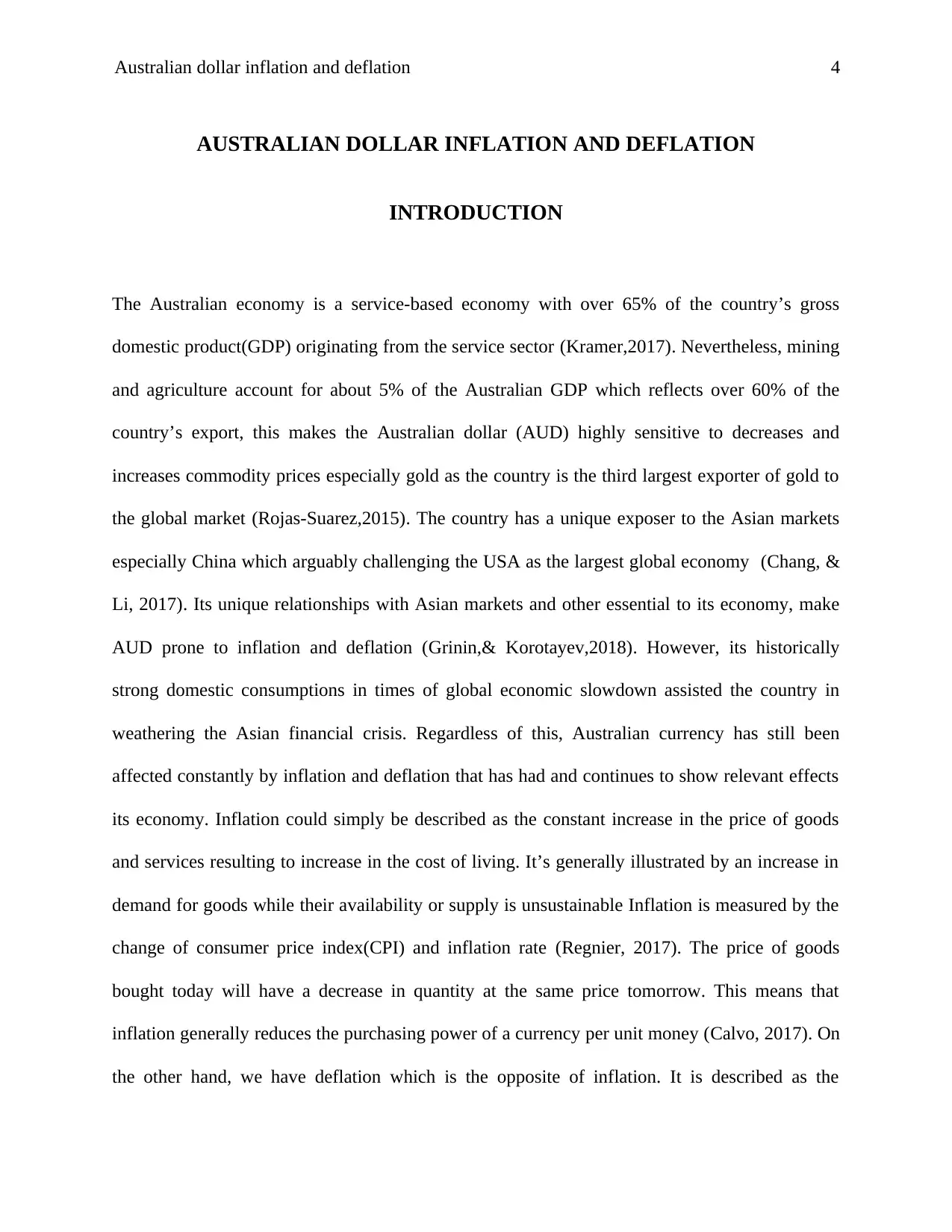
Australian dollar inflation and deflation 4
AUSTRALIAN DOLLAR INFLATION AND DEFLATION
INTRODUCTION
The Australian economy is a service-based economy with over 65% of the country’s gross
domestic product(GDP) originating from the service sector (Kramer,2017). Nevertheless, mining
and agriculture account for about 5% of the Australian GDP which reflects over 60% of the
country’s export, this makes the Australian dollar (AUD) highly sensitive to decreases and
increases commodity prices especially gold as the country is the third largest exporter of gold to
the global market (Rojas-Suarez,2015). The country has a unique exposer to the Asian markets
especially China which arguably challenging the USA as the largest global economy (Chang, &
Li, 2017). Its unique relationships with Asian markets and other essential to its economy, make
AUD prone to inflation and deflation (Grinin,& Korotayev,2018). However, its historically
strong domestic consumptions in times of global economic slowdown assisted the country in
weathering the Asian financial crisis. Regardless of this, Australian currency has still been
affected constantly by inflation and deflation that has had and continues to show relevant effects
its economy. Inflation could simply be described as the constant increase in the price of goods
and services resulting to increase in the cost of living. It’s generally illustrated by an increase in
demand for goods while their availability or supply is unsustainable Inflation is measured by the
change of consumer price index(CPI) and inflation rate (Regnier, 2017). The price of goods
bought today will have a decrease in quantity at the same price tomorrow. This means that
inflation generally reduces the purchasing power of a currency per unit money (Calvo, 2017). On
the other hand, we have deflation which is the opposite of inflation. It is described as the
AUSTRALIAN DOLLAR INFLATION AND DEFLATION
INTRODUCTION
The Australian economy is a service-based economy with over 65% of the country’s gross
domestic product(GDP) originating from the service sector (Kramer,2017). Nevertheless, mining
and agriculture account for about 5% of the Australian GDP which reflects over 60% of the
country’s export, this makes the Australian dollar (AUD) highly sensitive to decreases and
increases commodity prices especially gold as the country is the third largest exporter of gold to
the global market (Rojas-Suarez,2015). The country has a unique exposer to the Asian markets
especially China which arguably challenging the USA as the largest global economy (Chang, &
Li, 2017). Its unique relationships with Asian markets and other essential to its economy, make
AUD prone to inflation and deflation (Grinin,& Korotayev,2018). However, its historically
strong domestic consumptions in times of global economic slowdown assisted the country in
weathering the Asian financial crisis. Regardless of this, Australian currency has still been
affected constantly by inflation and deflation that has had and continues to show relevant effects
its economy. Inflation could simply be described as the constant increase in the price of goods
and services resulting to increase in the cost of living. It’s generally illustrated by an increase in
demand for goods while their availability or supply is unsustainable Inflation is measured by the
change of consumer price index(CPI) and inflation rate (Regnier, 2017). The price of goods
bought today will have a decrease in quantity at the same price tomorrow. This means that
inflation generally reduces the purchasing power of a currency per unit money (Calvo, 2017). On
the other hand, we have deflation which is the opposite of inflation. It is described as the
Secure Best Marks with AI Grader
Need help grading? Try our AI Grader for instant feedback on your assignments.
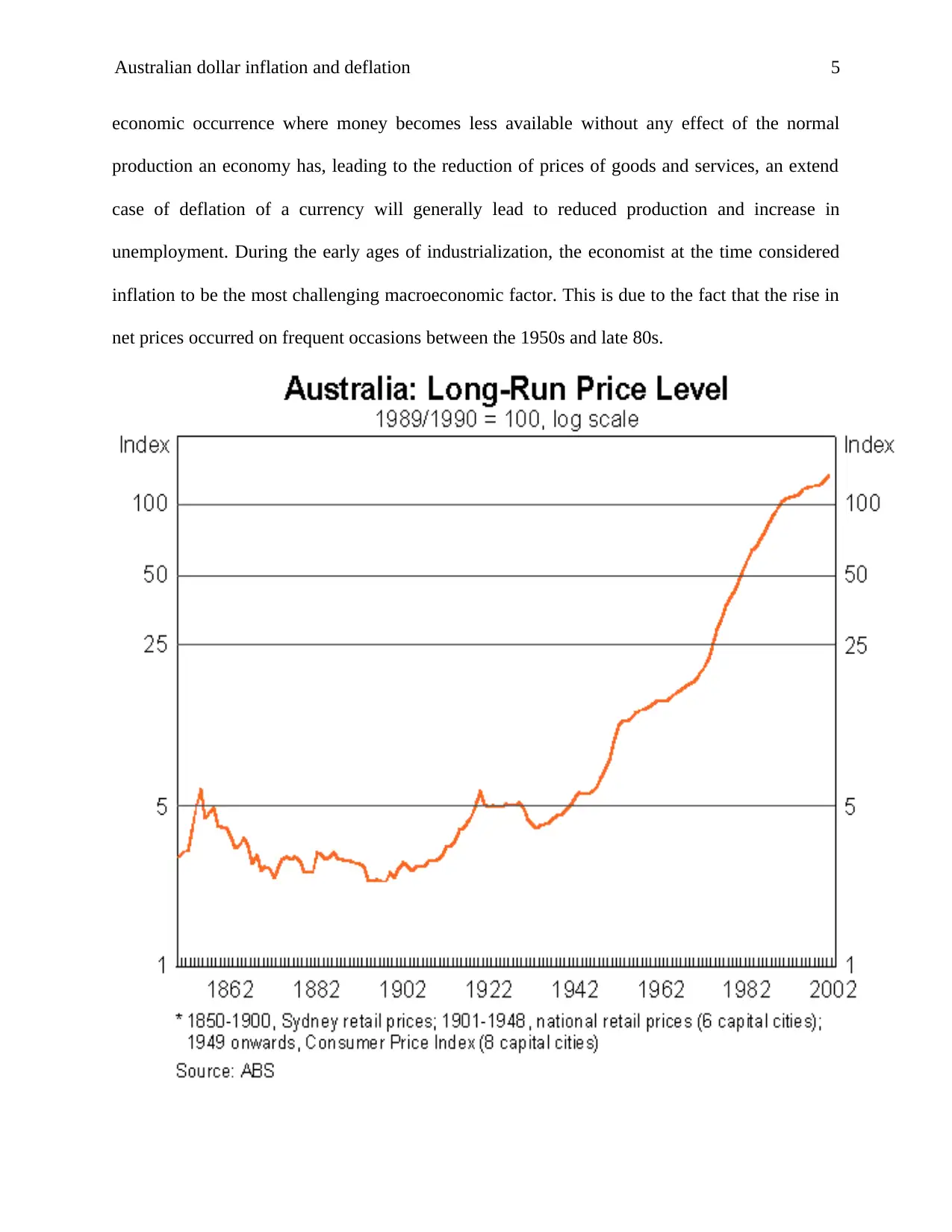
Australian dollar inflation and deflation 5
economic occurrence where money becomes less available without any effect of the normal
production an economy has, leading to the reduction of prices of goods and services, an extend
case of deflation of a currency will generally lead to reduced production and increase in
unemployment. During the early ages of industrialization, the economist at the time considered
inflation to be the most challenging macroeconomic factor. This is due to the fact that the rise in
net prices occurred on frequent occasions between the 1950s and late 80s.
economic occurrence where money becomes less available without any effect of the normal
production an economy has, leading to the reduction of prices of goods and services, an extend
case of deflation of a currency will generally lead to reduced production and increase in
unemployment. During the early ages of industrialization, the economist at the time considered
inflation to be the most challenging macroeconomic factor. This is due to the fact that the rise in
net prices occurred on frequent occasions between the 1950s and late 80s.

Australian dollar inflation and deflation 6
For Australia's situation, it was perceptible amid the 1950s that, in times of business cycle
downturn, costs quit rising yet didn't really fall. This was rather than the pre-World War II
encounter, where value levels fell amid retreats (Calvo, 2016). By the second 50% of the 1960s,
it was much clearer that the value level had obtained a determined upward pattern, and around
that time it ended up typical to take a gander at the value level in its first distinction frame as
opposed to its level. However, everything changed with the all-time high 20%inflation that
nearly destroyed the economy, monetary policies were created for the purpose of curbing
Australia’s inflation-deflation in the 70s.Inflation continued to the subdue the global economy
for a decade up to the the1990s (Anderson, Bordo & Duca, 2017).
The ensuing decade has been a time of low inflation globally. Most as of late, with a worldwide
business cycle downturn, inflation all around has declined further and is as of now low to
minimal in many spots. So, it is normal to ask whether, after an age agonizing over inflation, we
may be looked with deflation. Surely the word 'deflation' is utilized with considerably more
prominent recurrence than it has been for quite a while. Its utilization, as a rule, invokes some
dubious thought of the Great Depression, which was the last time a broad emptying occurrence.
So, it merits in looking at this in more detail. I need initially to be clear what we mean by empty,
at that point to ask whether it is in reality happening (Watanabe & Watanabe,2018). At that point
I need to get some information about it and assuming this is the case, what we may do to counter
it This paper will discuss the Australian dollar inflation and deflation while reviewing it current
For Australia's situation, it was perceptible amid the 1950s that, in times of business cycle
downturn, costs quit rising yet didn't really fall. This was rather than the pre-World War II
encounter, where value levels fell amid retreats (Calvo, 2016). By the second 50% of the 1960s,
it was much clearer that the value level had obtained a determined upward pattern, and around
that time it ended up typical to take a gander at the value level in its first distinction frame as
opposed to its level. However, everything changed with the all-time high 20%inflation that
nearly destroyed the economy, monetary policies were created for the purpose of curbing
Australia’s inflation-deflation in the 70s.Inflation continued to the subdue the global economy
for a decade up to the the1990s (Anderson, Bordo & Duca, 2017).
The ensuing decade has been a time of low inflation globally. Most as of late, with a worldwide
business cycle downturn, inflation all around has declined further and is as of now low to
minimal in many spots. So, it is normal to ask whether, after an age agonizing over inflation, we
may be looked with deflation. Surely the word 'deflation' is utilized with considerably more
prominent recurrence than it has been for quite a while. Its utilization, as a rule, invokes some
dubious thought of the Great Depression, which was the last time a broad emptying occurrence.
So, it merits in looking at this in more detail. I need initially to be clear what we mean by empty,
at that point to ask whether it is in reality happening (Watanabe & Watanabe,2018). At that point
I need to get some information about it and assuming this is the case, what we may do to counter
it This paper will discuss the Australian dollar inflation and deflation while reviewing it current
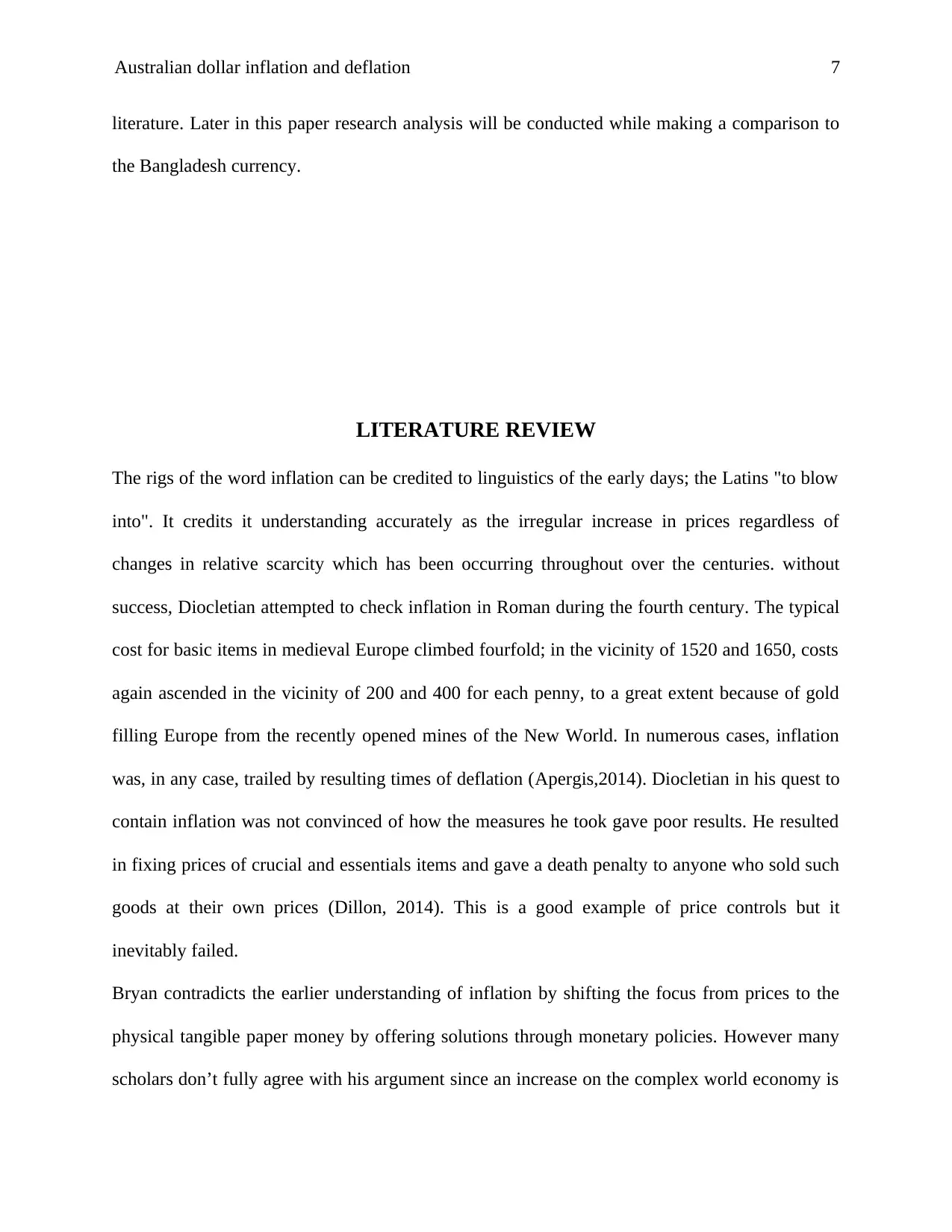
Australian dollar inflation and deflation 7
literature. Later in this paper research analysis will be conducted while making a comparison to
the Bangladesh currency.
LITERATURE REVIEW
The rigs of the word inflation can be credited to linguistics of the early days; the Latins "to blow
into". It credits it understanding accurately as the irregular increase in prices regardless of
changes in relative scarcity which has been occurring throughout over the centuries. without
success, Diocletian attempted to check inflation in Roman during the fourth century. The typical
cost for basic items in medieval Europe climbed fourfold; in the vicinity of 1520 and 1650, costs
again ascended in the vicinity of 200 and 400 for each penny, to a great extent because of gold
filling Europe from the recently opened mines of the New World. In numerous cases, inflation
was, in any case, trailed by resulting times of deflation (Apergis,2014). Diocletian in his quest to
contain inflation was not convinced of how the measures he took gave poor results. He resulted
in fixing prices of crucial and essentials items and gave a death penalty to anyone who sold such
goods at their own prices (Dillon, 2014). This is a good example of price controls but it
inevitably failed.
Bryan contradicts the earlier understanding of inflation by shifting the focus from prices to the
physical tangible paper money by offering solutions through monetary policies. However many
scholars don’t fully agree with his argument since an increase on the complex world economy is
literature. Later in this paper research analysis will be conducted while making a comparison to
the Bangladesh currency.
LITERATURE REVIEW
The rigs of the word inflation can be credited to linguistics of the early days; the Latins "to blow
into". It credits it understanding accurately as the irregular increase in prices regardless of
changes in relative scarcity which has been occurring throughout over the centuries. without
success, Diocletian attempted to check inflation in Roman during the fourth century. The typical
cost for basic items in medieval Europe climbed fourfold; in the vicinity of 1520 and 1650, costs
again ascended in the vicinity of 200 and 400 for each penny, to a great extent because of gold
filling Europe from the recently opened mines of the New World. In numerous cases, inflation
was, in any case, trailed by resulting times of deflation (Apergis,2014). Diocletian in his quest to
contain inflation was not convinced of how the measures he took gave poor results. He resulted
in fixing prices of crucial and essentials items and gave a death penalty to anyone who sold such
goods at their own prices (Dillon, 2014). This is a good example of price controls but it
inevitably failed.
Bryan contradicts the earlier understanding of inflation by shifting the focus from prices to the
physical tangible paper money by offering solutions through monetary policies. However many
scholars don’t fully agree with his argument since an increase on the complex world economy is
Paraphrase This Document
Need a fresh take? Get an instant paraphrase of this document with our AI Paraphraser
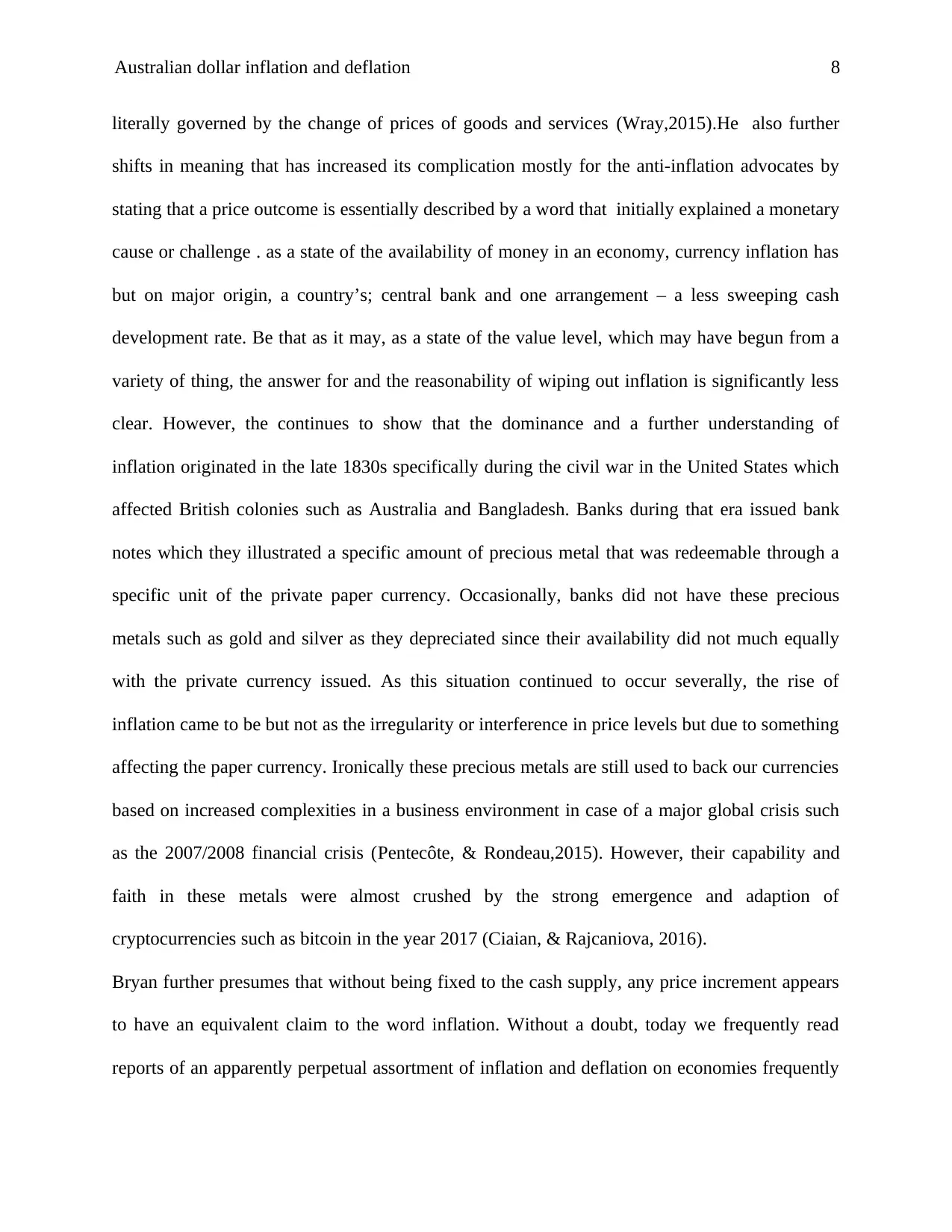
Australian dollar inflation and deflation 8
literally governed by the change of prices of goods and services (Wray,2015).He also further
shifts in meaning that has increased its complication mostly for the anti-inflation advocates by
stating that a price outcome is essentially described by a word that initially explained a monetary
cause or challenge . as a state of the availability of money in an economy, currency inflation has
but on major origin, a country’s; central bank and one arrangement – a less sweeping cash
development rate. Be that as it may, as a state of the value level, which may have begun from a
variety of thing, the answer for and the reasonability of wiping out inflation is significantly less
clear. However, the continues to show that the dominance and a further understanding of
inflation originated in the late 1830s specifically during the civil war in the United States which
affected British colonies such as Australia and Bangladesh. Banks during that era issued bank
notes which they illustrated a specific amount of precious metal that was redeemable through a
specific unit of the private paper currency. Occasionally, banks did not have these precious
metals such as gold and silver as they depreciated since their availability did not much equally
with the private currency issued. As this situation continued to occur severally, the rise of
inflation came to be but not as the irregularity or interference in price levels but due to something
affecting the paper currency. Ironically these precious metals are still used to back our currencies
based on increased complexities in a business environment in case of a major global crisis such
as the 2007/2008 financial crisis (Pentecôte, & Rondeau,2015). However, their capability and
faith in these metals were almost crushed by the strong emergence and adaption of
cryptocurrencies such as bitcoin in the year 2017 (Ciaian, & Rajcaniova, 2016).
Bryan further presumes that without being fixed to the cash supply, any price increment appears
to have an equivalent claim to the word inflation. Without a doubt, today we frequently read
reports of an apparently perpetual assortment of inflation and deflation on economies frequently
literally governed by the change of prices of goods and services (Wray,2015).He also further
shifts in meaning that has increased its complication mostly for the anti-inflation advocates by
stating that a price outcome is essentially described by a word that initially explained a monetary
cause or challenge . as a state of the availability of money in an economy, currency inflation has
but on major origin, a country’s; central bank and one arrangement – a less sweeping cash
development rate. Be that as it may, as a state of the value level, which may have begun from a
variety of thing, the answer for and the reasonability of wiping out inflation is significantly less
clear. However, the continues to show that the dominance and a further understanding of
inflation originated in the late 1830s specifically during the civil war in the United States which
affected British colonies such as Australia and Bangladesh. Banks during that era issued bank
notes which they illustrated a specific amount of precious metal that was redeemable through a
specific unit of the private paper currency. Occasionally, banks did not have these precious
metals such as gold and silver as they depreciated since their availability did not much equally
with the private currency issued. As this situation continued to occur severally, the rise of
inflation came to be but not as the irregularity or interference in price levels but due to something
affecting the paper currency. Ironically these precious metals are still used to back our currencies
based on increased complexities in a business environment in case of a major global crisis such
as the 2007/2008 financial crisis (Pentecôte, & Rondeau,2015). However, their capability and
faith in these metals were almost crushed by the strong emergence and adaption of
cryptocurrencies such as bitcoin in the year 2017 (Ciaian, & Rajcaniova, 2016).
Bryan further presumes that without being fixed to the cash supply, any price increment appears
to have an equivalent claim to the word inflation. Without a doubt, today we frequently read
reports of an apparently perpetual assortment of inflation and deflation on economies frequently
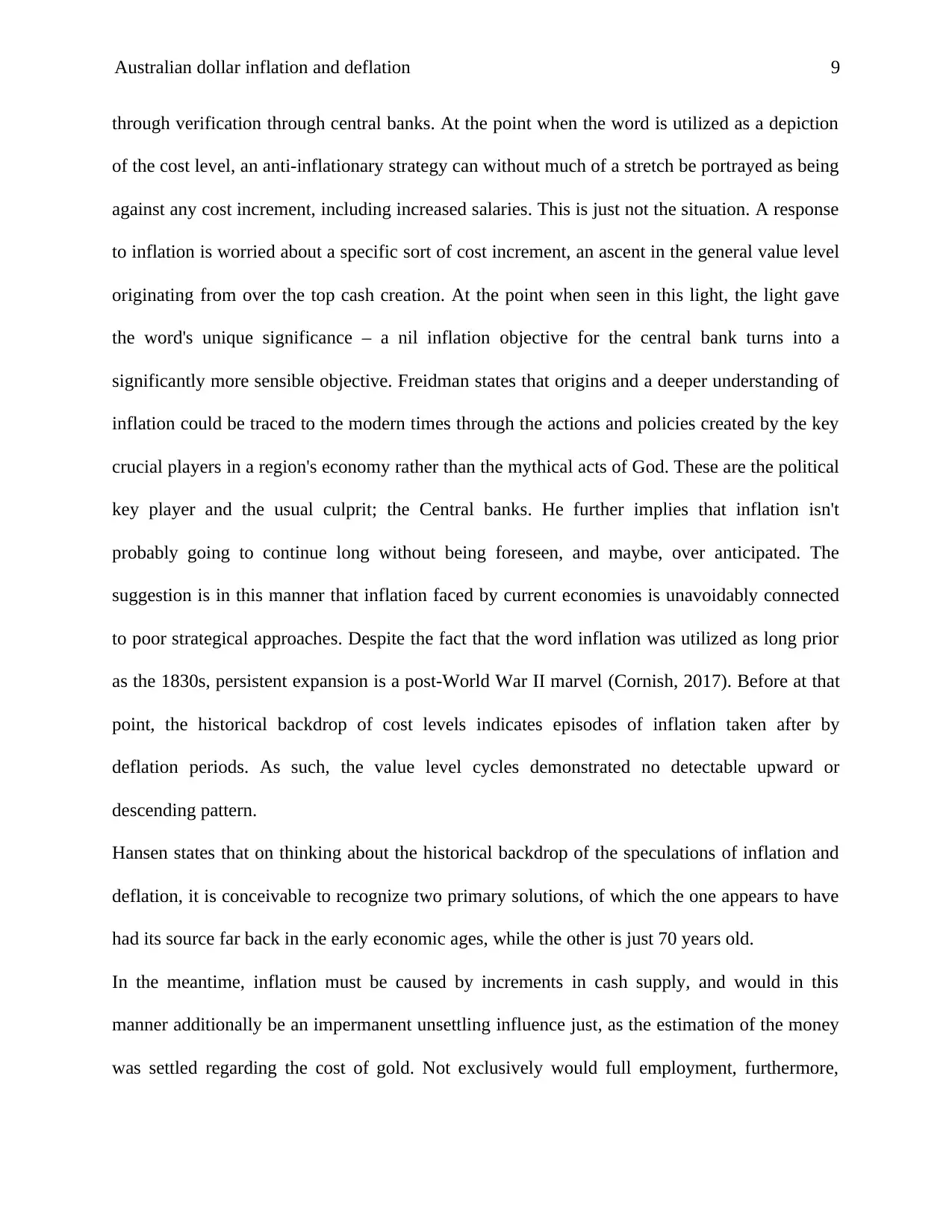
Australian dollar inflation and deflation 9
through verification through central banks. At the point when the word is utilized as a depiction
of the cost level, an anti-inflationary strategy can without much of a stretch be portrayed as being
against any cost increment, including increased salaries. This is just not the situation. A response
to inflation is worried about a specific sort of cost increment, an ascent in the general value level
originating from over the top cash creation. At the point when seen in this light, the light gave
the word's unique significance – a nil inflation objective for the central bank turns into a
significantly more sensible objective. Freidman states that origins and a deeper understanding of
inflation could be traced to the modern times through the actions and policies created by the key
crucial players in a region's economy rather than the mythical acts of God. These are the political
key player and the usual culprit; the Central banks. He further implies that inflation isn't
probably going to continue long without being foreseen, and maybe, over anticipated. The
suggestion is in this manner that inflation faced by current economies is unavoidably connected
to poor strategical approaches. Despite the fact that the word inflation was utilized as long prior
as the 1830s, persistent expansion is a post-World War II marvel (Cornish, 2017). Before at that
point, the historical backdrop of cost levels indicates episodes of inflation taken after by
deflation periods. As such, the value level cycles demonstrated no detectable upward or
descending pattern.
Hansen states that on thinking about the historical backdrop of the speculations of inflation and
deflation, it is conceivable to recognize two primary solutions, of which the one appears to have
had its source far back in the early economic ages, while the other is just 70 years old.
In the meantime, inflation must be caused by increments in cash supply, and would in this
manner additionally be an impermanent unsettling influence just, as the estimation of the money
was settled regarding the cost of gold. Not exclusively would full employment, furthermore,
through verification through central banks. At the point when the word is utilized as a depiction
of the cost level, an anti-inflationary strategy can without much of a stretch be portrayed as being
against any cost increment, including increased salaries. This is just not the situation. A response
to inflation is worried about a specific sort of cost increment, an ascent in the general value level
originating from over the top cash creation. At the point when seen in this light, the light gave
the word's unique significance – a nil inflation objective for the central bank turns into a
significantly more sensible objective. Freidman states that origins and a deeper understanding of
inflation could be traced to the modern times through the actions and policies created by the key
crucial players in a region's economy rather than the mythical acts of God. These are the political
key player and the usual culprit; the Central banks. He further implies that inflation isn't
probably going to continue long without being foreseen, and maybe, over anticipated. The
suggestion is in this manner that inflation faced by current economies is unavoidably connected
to poor strategical approaches. Despite the fact that the word inflation was utilized as long prior
as the 1830s, persistent expansion is a post-World War II marvel (Cornish, 2017). Before at that
point, the historical backdrop of cost levels indicates episodes of inflation taken after by
deflation periods. As such, the value level cycles demonstrated no detectable upward or
descending pattern.
Hansen states that on thinking about the historical backdrop of the speculations of inflation and
deflation, it is conceivable to recognize two primary solutions, of which the one appears to have
had its source far back in the early economic ages, while the other is just 70 years old.
In the meantime, inflation must be caused by increments in cash supply, and would in this
manner additionally be an impermanent unsettling influence just, as the estimation of the money
was settled regarding the cost of gold. Not exclusively would full employment, furthermore,
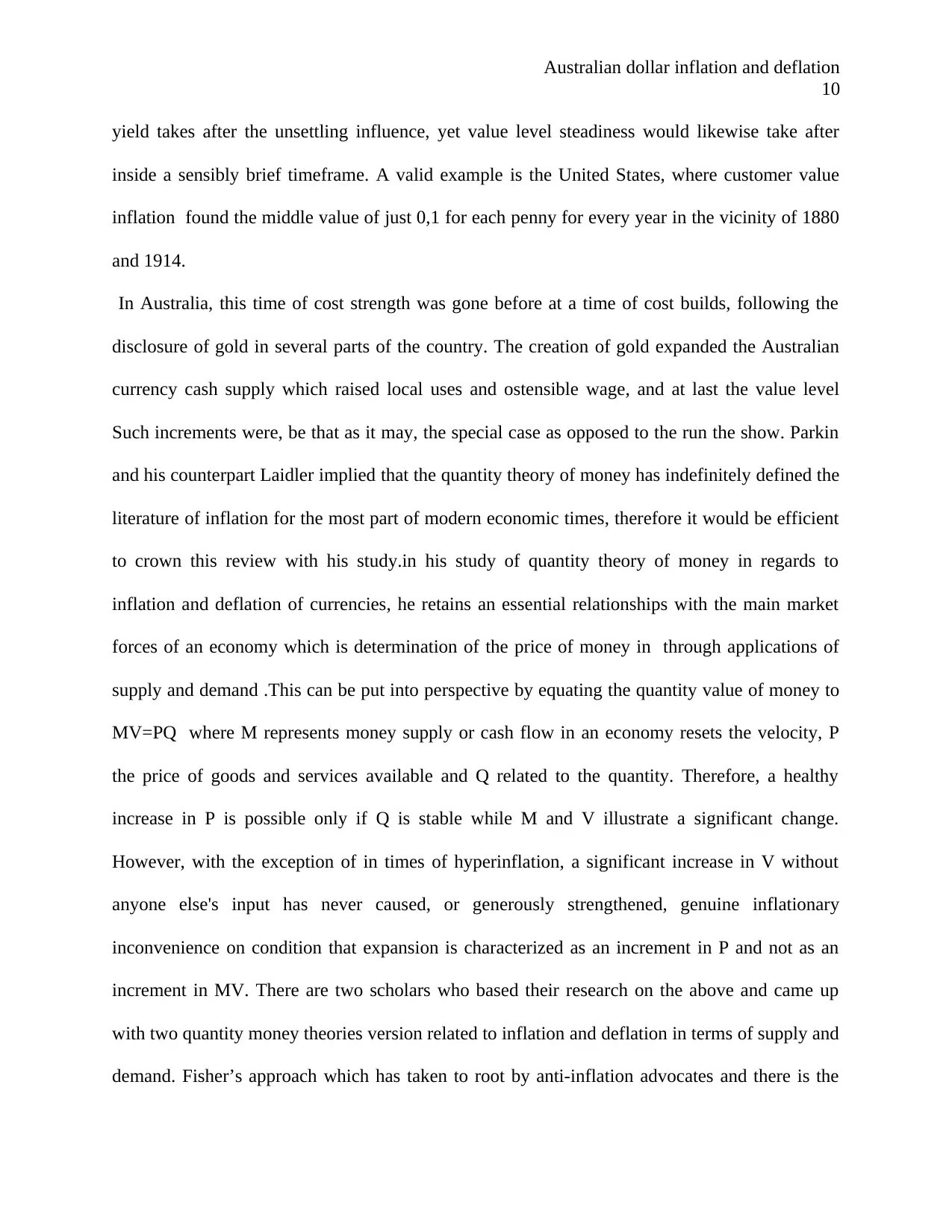
Australian dollar inflation and deflation
10
yield takes after the unsettling influence, yet value level steadiness would likewise take after
inside a sensibly brief timeframe. A valid example is the United States, where customer value
inflation found the middle value of just 0,1 for each penny for every year in the vicinity of 1880
and 1914.
In Australia, this time of cost strength was gone before at a time of cost builds, following the
disclosure of gold in several parts of the country. The creation of gold expanded the Australian
currency cash supply which raised local uses and ostensible wage, and at last the value level
Such increments were, be that as it may, the special case as opposed to the run the show. Parkin
and his counterpart Laidler implied that the quantity theory of money has indefinitely defined the
literature of inflation for the most part of modern economic times, therefore it would be efficient
to crown this review with his study.in his study of quantity theory of money in regards to
inflation and deflation of currencies, he retains an essential relationships with the main market
forces of an economy which is determination of the price of money in through applications of
supply and demand .This can be put into perspective by equating the quantity value of money to
MV=PQ where M represents money supply or cash flow in an economy resets the velocity, P
the price of goods and services available and Q related to the quantity. Therefore, a healthy
increase in P is possible only if Q is stable while M and V illustrate a significant change.
However, with the exception of in times of hyperinflation, a significant increase in V without
anyone else's input has never caused, or generously strengthened, genuine inflationary
inconvenience on condition that expansion is characterized as an increment in P and not as an
increment in MV. There are two scholars who based their research on the above and came up
with two quantity money theories version related to inflation and deflation in terms of supply and
demand. Fisher’s approach which has taken to root by anti-inflation advocates and there is the
10
yield takes after the unsettling influence, yet value level steadiness would likewise take after
inside a sensibly brief timeframe. A valid example is the United States, where customer value
inflation found the middle value of just 0,1 for each penny for every year in the vicinity of 1880
and 1914.
In Australia, this time of cost strength was gone before at a time of cost builds, following the
disclosure of gold in several parts of the country. The creation of gold expanded the Australian
currency cash supply which raised local uses and ostensible wage, and at last the value level
Such increments were, be that as it may, the special case as opposed to the run the show. Parkin
and his counterpart Laidler implied that the quantity theory of money has indefinitely defined the
literature of inflation for the most part of modern economic times, therefore it would be efficient
to crown this review with his study.in his study of quantity theory of money in regards to
inflation and deflation of currencies, he retains an essential relationships with the main market
forces of an economy which is determination of the price of money in through applications of
supply and demand .This can be put into perspective by equating the quantity value of money to
MV=PQ where M represents money supply or cash flow in an economy resets the velocity, P
the price of goods and services available and Q related to the quantity. Therefore, a healthy
increase in P is possible only if Q is stable while M and V illustrate a significant change.
However, with the exception of in times of hyperinflation, a significant increase in V without
anyone else's input has never caused, or generously strengthened, genuine inflationary
inconvenience on condition that expansion is characterized as an increment in P and not as an
increment in MV. There are two scholars who based their research on the above and came up
with two quantity money theories version related to inflation and deflation in terms of supply and
demand. Fisher’s approach which has taken to root by anti-inflation advocates and there is the
Secure Best Marks with AI Grader
Need help grading? Try our AI Grader for instant feedback on your assignments.
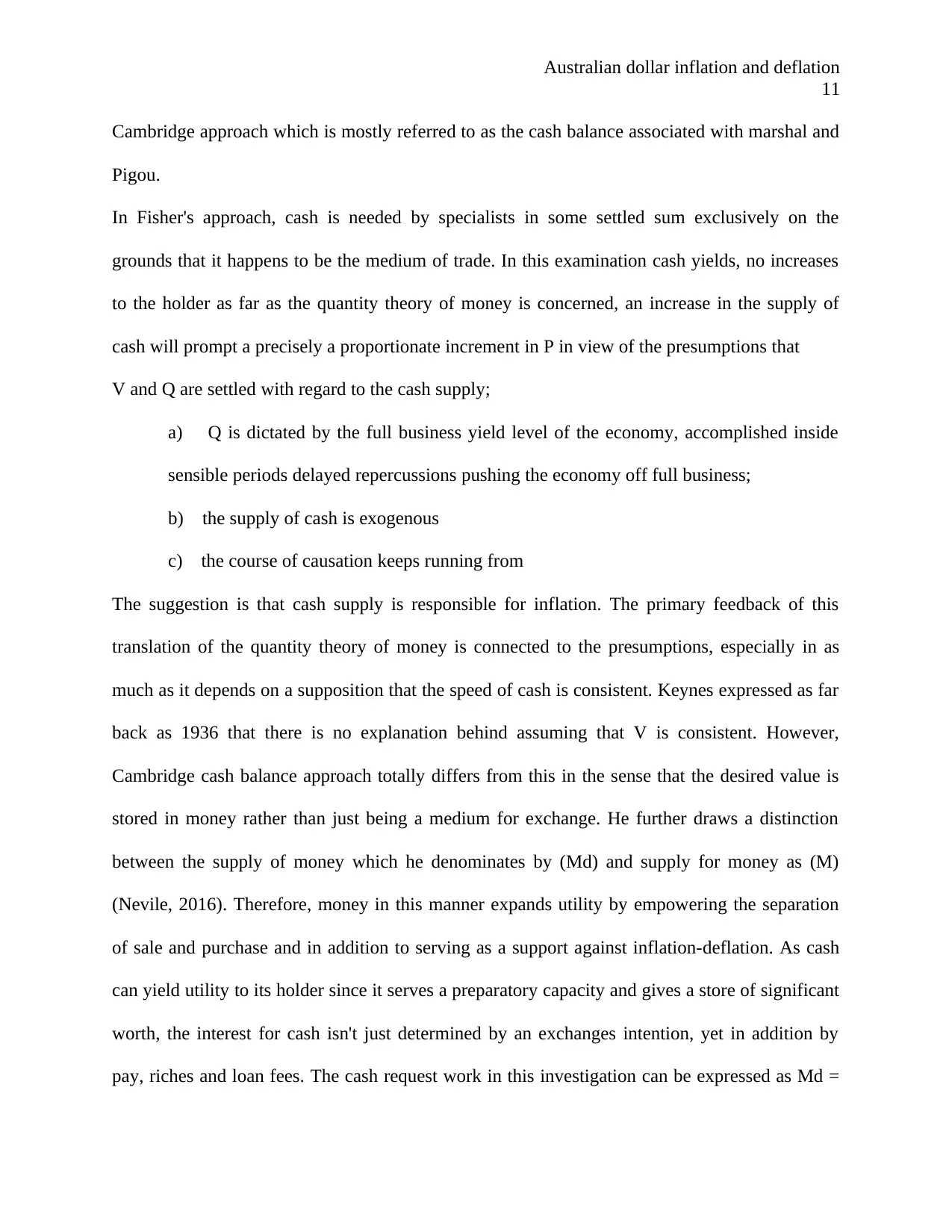
Australian dollar inflation and deflation
11
Cambridge approach which is mostly referred to as the cash balance associated with marshal and
Pigou.
In Fisher's approach, cash is needed by specialists in some settled sum exclusively on the
grounds that it happens to be the medium of trade. In this examination cash yields, no increases
to the holder as far as the quantity theory of money is concerned, an increase in the supply of
cash will prompt a precisely a proportionate increment in P in view of the presumptions that
V and Q are settled with regard to the cash supply;
a) Q is dictated by the full business yield level of the economy, accomplished inside
sensible periods delayed repercussions pushing the economy off full business;
b) the supply of cash is exogenous
c) the course of causation keeps running from
The suggestion is that cash supply is responsible for inflation. The primary feedback of this
translation of the quantity theory of money is connected to the presumptions, especially in as
much as it depends on a supposition that the speed of cash is consistent. Keynes expressed as far
back as 1936 that there is no explanation behind assuming that V is consistent. However,
Cambridge cash balance approach totally differs from this in the sense that the desired value is
stored in money rather than just being a medium for exchange. He further draws a distinction
between the supply of money which he denominates by (Md) and supply for money as (M)
(Nevile, 2016). Therefore, money in this manner expands utility by empowering the separation
of sale and purchase and in addition to serving as a support against inflation-deflation. As cash
can yield utility to its holder since it serves a preparatory capacity and gives a store of significant
worth, the interest for cash isn't just determined by an exchanges intention, yet in addition by
pay, riches and loan fees. The cash request work in this investigation can be expressed as Md =
11
Cambridge approach which is mostly referred to as the cash balance associated with marshal and
Pigou.
In Fisher's approach, cash is needed by specialists in some settled sum exclusively on the
grounds that it happens to be the medium of trade. In this examination cash yields, no increases
to the holder as far as the quantity theory of money is concerned, an increase in the supply of
cash will prompt a precisely a proportionate increment in P in view of the presumptions that
V and Q are settled with regard to the cash supply;
a) Q is dictated by the full business yield level of the economy, accomplished inside
sensible periods delayed repercussions pushing the economy off full business;
b) the supply of cash is exogenous
c) the course of causation keeps running from
The suggestion is that cash supply is responsible for inflation. The primary feedback of this
translation of the quantity theory of money is connected to the presumptions, especially in as
much as it depends on a supposition that the speed of cash is consistent. Keynes expressed as far
back as 1936 that there is no explanation behind assuming that V is consistent. However,
Cambridge cash balance approach totally differs from this in the sense that the desired value is
stored in money rather than just being a medium for exchange. He further draws a distinction
between the supply of money which he denominates by (Md) and supply for money as (M)
(Nevile, 2016). Therefore, money in this manner expands utility by empowering the separation
of sale and purchase and in addition to serving as a support against inflation-deflation. As cash
can yield utility to its holder since it serves a preparatory capacity and gives a store of significant
worth, the interest for cash isn't just determined by an exchanges intention, yet in addition by
pay, riches and loan fees. The cash request work in this investigation can be expressed as Md =
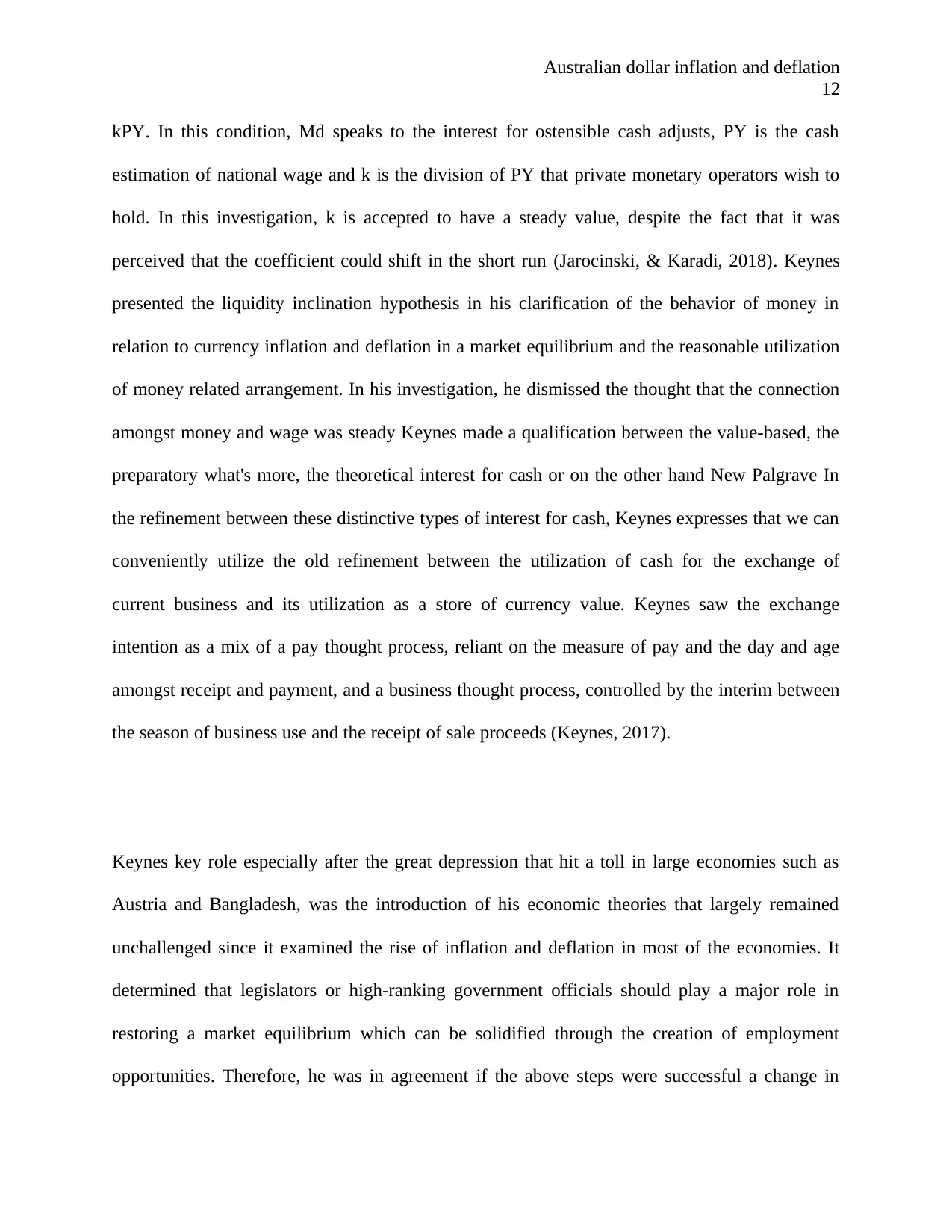
Australian dollar inflation and deflation
12
kPY. In this condition, Md speaks to the interest for ostensible cash adjusts, PY is the cash
estimation of national wage and k is the division of PY that private monetary operators wish to
hold. In this investigation, k is accepted to have a steady value, despite the fact that it was
perceived that the coefficient could shift in the short run (Jarocinski, & Karadi, 2018). Keynes
presented the liquidity inclination hypothesis in his clarification of the behavior of money in
relation to currency inflation and deflation in a market equilibrium and the reasonable utilization
of money related arrangement. In his investigation, he dismissed the thought that the connection
amongst money and wage was steady Keynes made a qualification between the value-based, the
preparatory what's more, the theoretical interest for cash or on the other hand New Palgrave In
the refinement between these distinctive types of interest for cash, Keynes expresses that we can
conveniently utilize the old refinement between the utilization of cash for the exchange of
current business and its utilization as a store of currency value. Keynes saw the exchange
intention as a mix of a pay thought process, reliant on the measure of pay and the day and age
amongst receipt and payment, and a business thought process, controlled by the interim between
the season of business use and the receipt of sale proceeds (Keynes, 2017).
Keynes key role especially after the great depression that hit a toll in large economies such as
Austria and Bangladesh, was the introduction of his economic theories that largely remained
unchallenged since it examined the rise of inflation and deflation in most of the economies. It
determined that legislators or high-ranking government officials should play a major role in
restoring a market equilibrium which can be solidified through the creation of employment
opportunities. Therefore, he was in agreement if the above steps were successful a change in
12
kPY. In this condition, Md speaks to the interest for ostensible cash adjusts, PY is the cash
estimation of national wage and k is the division of PY that private monetary operators wish to
hold. In this investigation, k is accepted to have a steady value, despite the fact that it was
perceived that the coefficient could shift in the short run (Jarocinski, & Karadi, 2018). Keynes
presented the liquidity inclination hypothesis in his clarification of the behavior of money in
relation to currency inflation and deflation in a market equilibrium and the reasonable utilization
of money related arrangement. In his investigation, he dismissed the thought that the connection
amongst money and wage was steady Keynes made a qualification between the value-based, the
preparatory what's more, the theoretical interest for cash or on the other hand New Palgrave In
the refinement between these distinctive types of interest for cash, Keynes expresses that we can
conveniently utilize the old refinement between the utilization of cash for the exchange of
current business and its utilization as a store of currency value. Keynes saw the exchange
intention as a mix of a pay thought process, reliant on the measure of pay and the day and age
amongst receipt and payment, and a business thought process, controlled by the interim between
the season of business use and the receipt of sale proceeds (Keynes, 2017).
Keynes key role especially after the great depression that hit a toll in large economies such as
Austria and Bangladesh, was the introduction of his economic theories that largely remained
unchallenged since it examined the rise of inflation and deflation in most of the economies. It
determined that legislators or high-ranking government officials should play a major role in
restoring a market equilibrium which can be solidified through the creation of employment
opportunities. Therefore, he was in agreement if the above steps were successful a change in
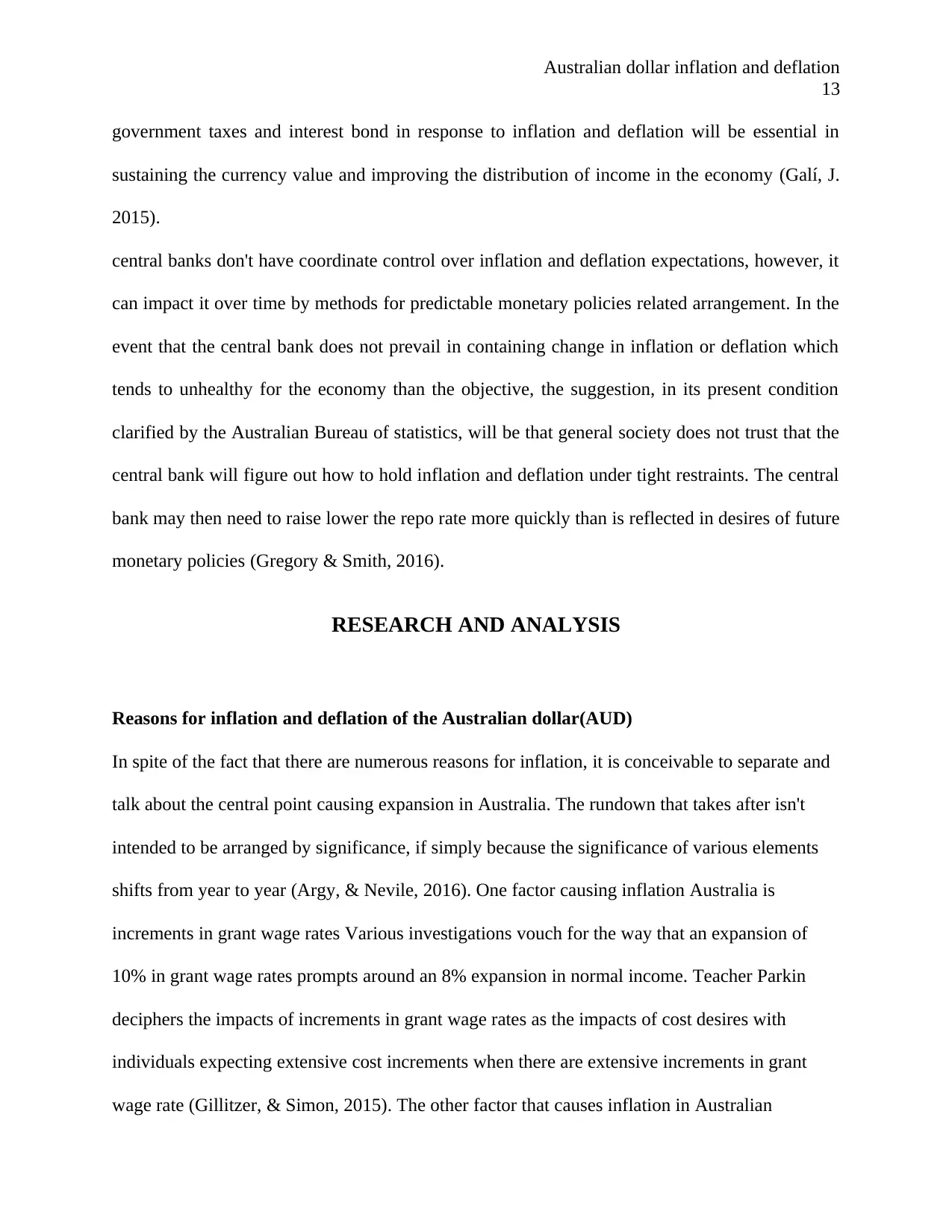
Australian dollar inflation and deflation
13
government taxes and interest bond in response to inflation and deflation will be essential in
sustaining the currency value and improving the distribution of income in the economy (Galí, J.
2015).
central banks don't have coordinate control over inflation and deflation expectations, however, it
can impact it over time by methods for predictable monetary policies related arrangement. In the
event that the central bank does not prevail in containing change in inflation or deflation which
tends to unhealthy for the economy than the objective, the suggestion, in its present condition
clarified by the Australian Bureau of statistics, will be that general society does not trust that the
central bank will figure out how to hold inflation and deflation under tight restraints. The central
bank may then need to raise lower the repo rate more quickly than is reflected in desires of future
monetary policies (Gregory & Smith, 2016).
RESEARCH AND ANALYSIS
Reasons for inflation and deflation of the Australian dollar(AUD)
In spite of the fact that there are numerous reasons for inflation, it is conceivable to separate and
talk about the central point causing expansion in Australia. The rundown that takes after isn't
intended to be arranged by significance, if simply because the significance of various elements
shifts from year to year (Argy, & Nevile, 2016). One factor causing inflation Australia is
increments in grant wage rates Various investigations vouch for the way that an expansion of
10% in grant wage rates prompts around an 8% expansion in normal income. Teacher Parkin
deciphers the impacts of increments in grant wage rates as the impacts of cost desires with
individuals expecting extensive cost increments when there are extensive increments in grant
wage rate (Gillitzer, & Simon, 2015). The other factor that causes inflation in Australian
13
government taxes and interest bond in response to inflation and deflation will be essential in
sustaining the currency value and improving the distribution of income in the economy (Galí, J.
2015).
central banks don't have coordinate control over inflation and deflation expectations, however, it
can impact it over time by methods for predictable monetary policies related arrangement. In the
event that the central bank does not prevail in containing change in inflation or deflation which
tends to unhealthy for the economy than the objective, the suggestion, in its present condition
clarified by the Australian Bureau of statistics, will be that general society does not trust that the
central bank will figure out how to hold inflation and deflation under tight restraints. The central
bank may then need to raise lower the repo rate more quickly than is reflected in desires of future
monetary policies (Gregory & Smith, 2016).
RESEARCH AND ANALYSIS
Reasons for inflation and deflation of the Australian dollar(AUD)
In spite of the fact that there are numerous reasons for inflation, it is conceivable to separate and
talk about the central point causing expansion in Australia. The rundown that takes after isn't
intended to be arranged by significance, if simply because the significance of various elements
shifts from year to year (Argy, & Nevile, 2016). One factor causing inflation Australia is
increments in grant wage rates Various investigations vouch for the way that an expansion of
10% in grant wage rates prompts around an 8% expansion in normal income. Teacher Parkin
deciphers the impacts of increments in grant wage rates as the impacts of cost desires with
individuals expecting extensive cost increments when there are extensive increments in grant
wage rate (Gillitzer, & Simon, 2015). The other factor that causes inflation in Australian
Paraphrase This Document
Need a fresh take? Get an instant paraphrase of this document with our AI Paraphraser
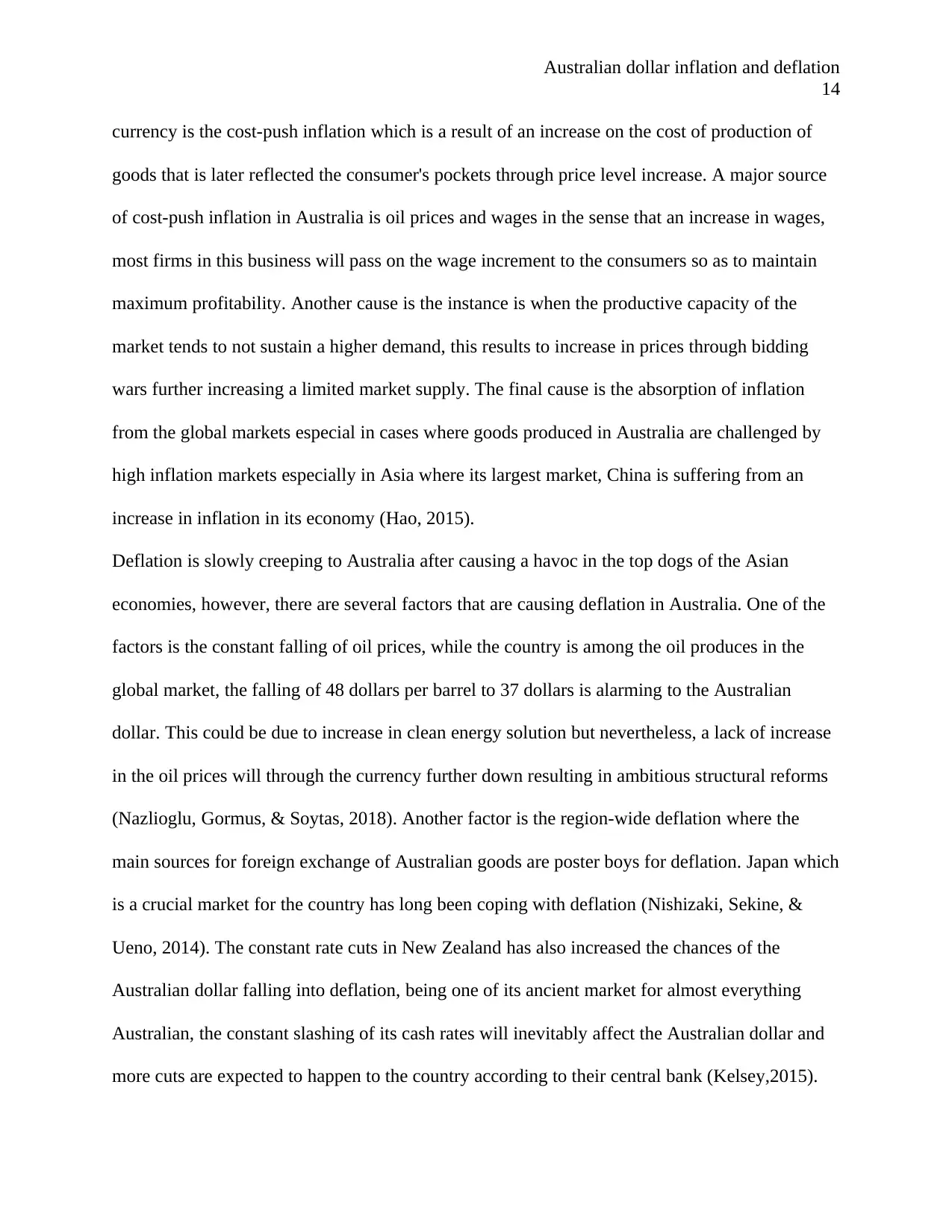
Australian dollar inflation and deflation
14
currency is the cost-push inflation which is a result of an increase on the cost of production of
goods that is later reflected the consumer's pockets through price level increase. A major source
of cost-push inflation in Australia is oil prices and wages in the sense that an increase in wages,
most firms in this business will pass on the wage increment to the consumers so as to maintain
maximum profitability. Another cause is the instance is when the productive capacity of the
market tends to not sustain a higher demand, this results to increase in prices through bidding
wars further increasing a limited market supply. The final cause is the absorption of inflation
from the global markets especial in cases where goods produced in Australia are challenged by
high inflation markets especially in Asia where its largest market, China is suffering from an
increase in inflation in its economy (Hao, 2015).
Deflation is slowly creeping to Australia after causing a havoc in the top dogs of the Asian
economies, however, there are several factors that are causing deflation in Australia. One of the
factors is the constant falling of oil prices, while the country is among the oil produces in the
global market, the falling of 48 dollars per barrel to 37 dollars is alarming to the Australian
dollar. This could be due to increase in clean energy solution but nevertheless, a lack of increase
in the oil prices will through the currency further down resulting in ambitious structural reforms
(Nazlioglu, Gormus, & Soytas, 2018). Another factor is the region-wide deflation where the
main sources for foreign exchange of Australian goods are poster boys for deflation. Japan which
is a crucial market for the country has long been coping with deflation (Nishizaki, Sekine, &
Ueno, 2014). The constant rate cuts in New Zealand has also increased the chances of the
Australian dollar falling into deflation, being one of its ancient market for almost everything
Australian, the constant slashing of its cash rates will inevitably affect the Australian dollar and
more cuts are expected to happen to the country according to their central bank (Kelsey,2015).
14
currency is the cost-push inflation which is a result of an increase on the cost of production of
goods that is later reflected the consumer's pockets through price level increase. A major source
of cost-push inflation in Australia is oil prices and wages in the sense that an increase in wages,
most firms in this business will pass on the wage increment to the consumers so as to maintain
maximum profitability. Another cause is the instance is when the productive capacity of the
market tends to not sustain a higher demand, this results to increase in prices through bidding
wars further increasing a limited market supply. The final cause is the absorption of inflation
from the global markets especial in cases where goods produced in Australia are challenged by
high inflation markets especially in Asia where its largest market, China is suffering from an
increase in inflation in its economy (Hao, 2015).
Deflation is slowly creeping to Australia after causing a havoc in the top dogs of the Asian
economies, however, there are several factors that are causing deflation in Australia. One of the
factors is the constant falling of oil prices, while the country is among the oil produces in the
global market, the falling of 48 dollars per barrel to 37 dollars is alarming to the Australian
dollar. This could be due to increase in clean energy solution but nevertheless, a lack of increase
in the oil prices will through the currency further down resulting in ambitious structural reforms
(Nazlioglu, Gormus, & Soytas, 2018). Another factor is the region-wide deflation where the
main sources for foreign exchange of Australian goods are poster boys for deflation. Japan which
is a crucial market for the country has long been coping with deflation (Nishizaki, Sekine, &
Ueno, 2014). The constant rate cuts in New Zealand has also increased the chances of the
Australian dollar falling into deflation, being one of its ancient market for almost everything
Australian, the constant slashing of its cash rates will inevitably affect the Australian dollar and
more cuts are expected to happen to the country according to their central bank (Kelsey,2015).
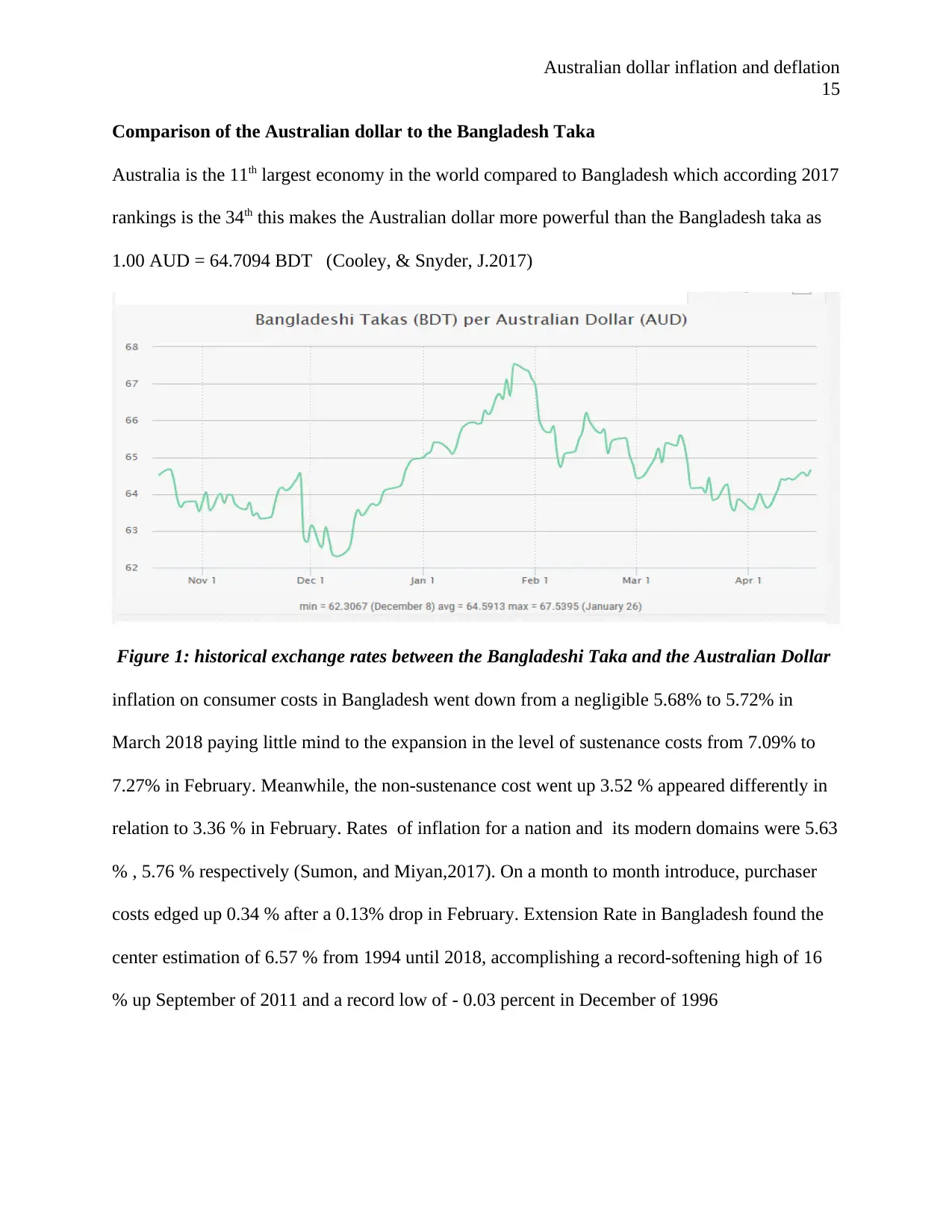
Australian dollar inflation and deflation
15
Comparison of the Australian dollar to the Bangladesh Taka
Australia is the 11th largest economy in the world compared to Bangladesh which according 2017
rankings is the 34th this makes the Australian dollar more powerful than the Bangladesh taka as
1.00 AUD = 64.7094 BDT (Cooley, & Snyder, J.2017)
Figure 1: historical exchange rates between the Bangladeshi Taka and the Australian Dollar
inflation on consumer costs in Bangladesh went down from a negligible 5.68% to 5.72% in
March 2018 paying little mind to the expansion in the level of sustenance costs from 7.09% to
7.27% in February. Meanwhile, the non-sustenance cost went up 3.52 % appeared differently in
relation to 3.36 % in February. Rates of inflation for a nation and its modern domains were 5.63
% , 5.76 % respectively (Sumon, and Miyan,2017). On a month to month introduce, purchaser
costs edged up 0.34 % after a 0.13% drop in February. Extension Rate in Bangladesh found the
center estimation of 6.57 % from 1994 until 2018, accomplishing a record-softening high of 16
% up September of 2011 and a record low of - 0.03 percent in December of 1996
15
Comparison of the Australian dollar to the Bangladesh Taka
Australia is the 11th largest economy in the world compared to Bangladesh which according 2017
rankings is the 34th this makes the Australian dollar more powerful than the Bangladesh taka as
1.00 AUD = 64.7094 BDT (Cooley, & Snyder, J.2017)
Figure 1: historical exchange rates between the Bangladeshi Taka and the Australian Dollar
inflation on consumer costs in Bangladesh went down from a negligible 5.68% to 5.72% in
March 2018 paying little mind to the expansion in the level of sustenance costs from 7.09% to
7.27% in February. Meanwhile, the non-sustenance cost went up 3.52 % appeared differently in
relation to 3.36 % in February. Rates of inflation for a nation and its modern domains were 5.63
% , 5.76 % respectively (Sumon, and Miyan,2017). On a month to month introduce, purchaser
costs edged up 0.34 % after a 0.13% drop in February. Extension Rate in Bangladesh found the
center estimation of 6.57 % from 1994 until 2018, accomplishing a record-softening high of 16
% up September of 2011 and a record low of - 0.03 percent in December of 1996
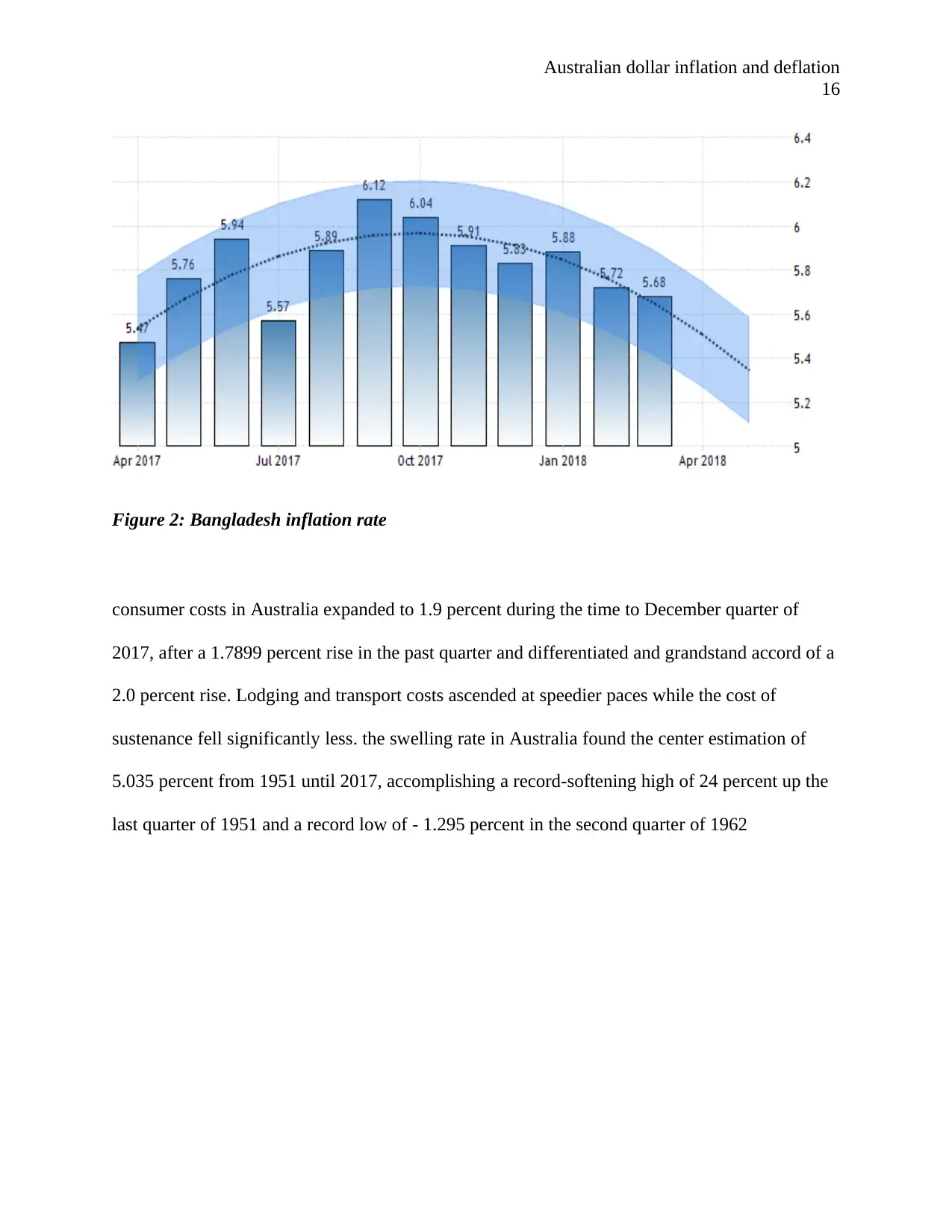
Australian dollar inflation and deflation
16
Figure 2: Bangladesh inflation rate
consumer costs in Australia expanded to 1.9 percent during the time to December quarter of
2017, after a 1.7899 percent rise in the past quarter and differentiated and grandstand accord of a
2.0 percent rise. Lodging and transport costs ascended at speedier paces while the cost of
sustenance fell significantly less. the swelling rate in Australia found the center estimation of
5.035 percent from 1951 until 2017, accomplishing a record-softening high of 24 percent up the
last quarter of 1951 and a record low of - 1.295 percent in the second quarter of 1962
16
Figure 2: Bangladesh inflation rate
consumer costs in Australia expanded to 1.9 percent during the time to December quarter of
2017, after a 1.7899 percent rise in the past quarter and differentiated and grandstand accord of a
2.0 percent rise. Lodging and transport costs ascended at speedier paces while the cost of
sustenance fell significantly less. the swelling rate in Australia found the center estimation of
5.035 percent from 1951 until 2017, accomplishing a record-softening high of 24 percent up the
last quarter of 1951 and a record low of - 1.295 percent in the second quarter of 1962
Secure Best Marks with AI Grader
Need help grading? Try our AI Grader for instant feedback on your assignments.
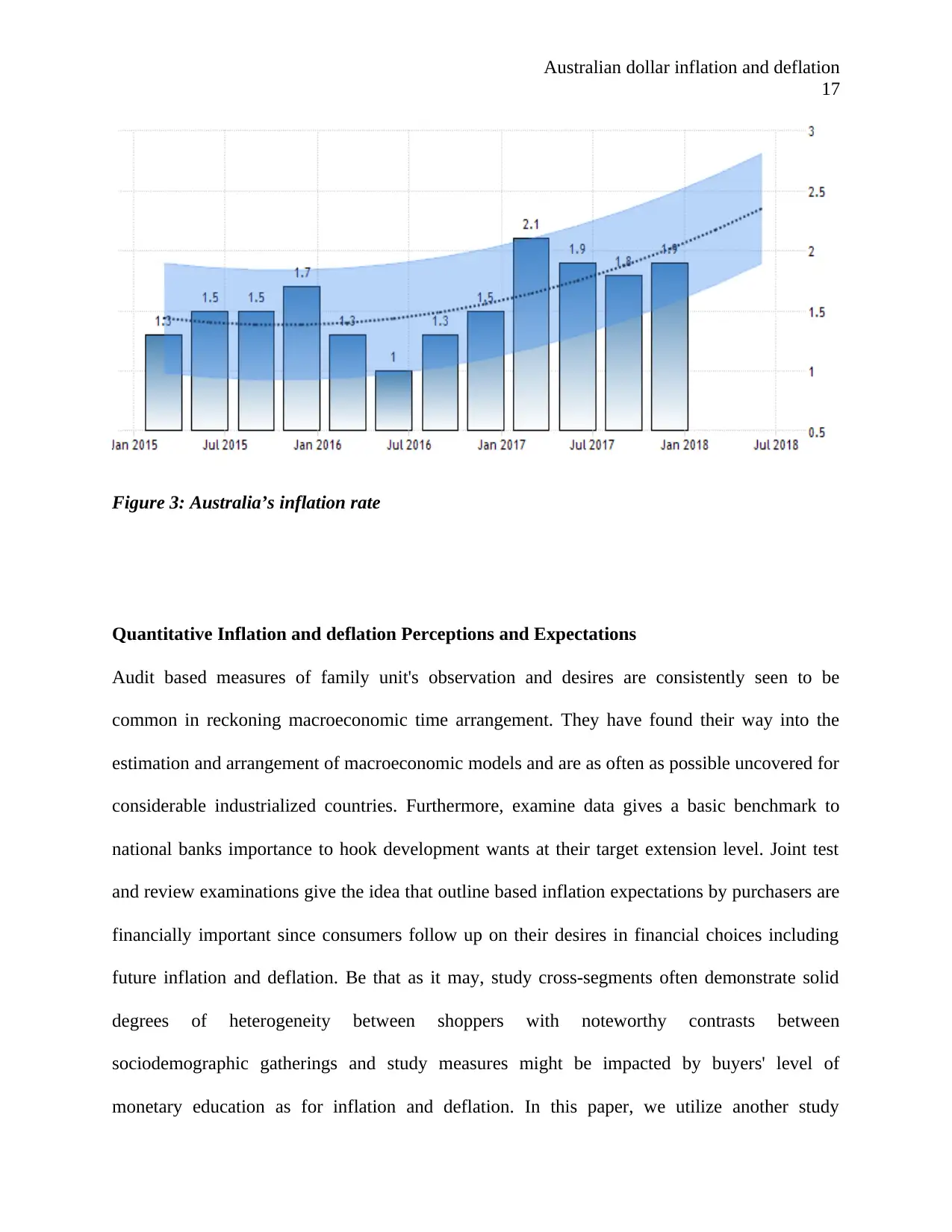
Australian dollar inflation and deflation
17
Figure 3: Australia’s inflation rate
Quantitative Inflation and deflation Perceptions and Expectations
Audit based measures of family unit's observation and desires are consistently seen to be
common in reckoning macroeconomic time arrangement. They have found their way into the
estimation and arrangement of macroeconomic models and are as often as possible uncovered for
considerable industrialized countries. Furthermore, examine data gives a basic benchmark to
national banks importance to hook development wants at their target extension level. Joint test
and review examinations give the idea that outline based inflation expectations by purchasers are
financially important since consumers follow up on their desires in financial choices including
future inflation and deflation. Be that as it may, study cross-segments often demonstrate solid
degrees of heterogeneity between shoppers with noteworthy contrasts between
sociodemographic gatherings and study measures might be impacted by buyers' level of
monetary education as for inflation and deflation. In this paper, we utilize another study
17
Figure 3: Australia’s inflation rate
Quantitative Inflation and deflation Perceptions and Expectations
Audit based measures of family unit's observation and desires are consistently seen to be
common in reckoning macroeconomic time arrangement. They have found their way into the
estimation and arrangement of macroeconomic models and are as often as possible uncovered for
considerable industrialized countries. Furthermore, examine data gives a basic benchmark to
national banks importance to hook development wants at their target extension level. Joint test
and review examinations give the idea that outline based inflation expectations by purchasers are
financially important since consumers follow up on their desires in financial choices including
future inflation and deflation. Be that as it may, study cross-segments often demonstrate solid
degrees of heterogeneity between shoppers with noteworthy contrasts between
sociodemographic gatherings and study measures might be impacted by buyers' level of
monetary education as for inflation and deflation. In this paper, we utilize another study
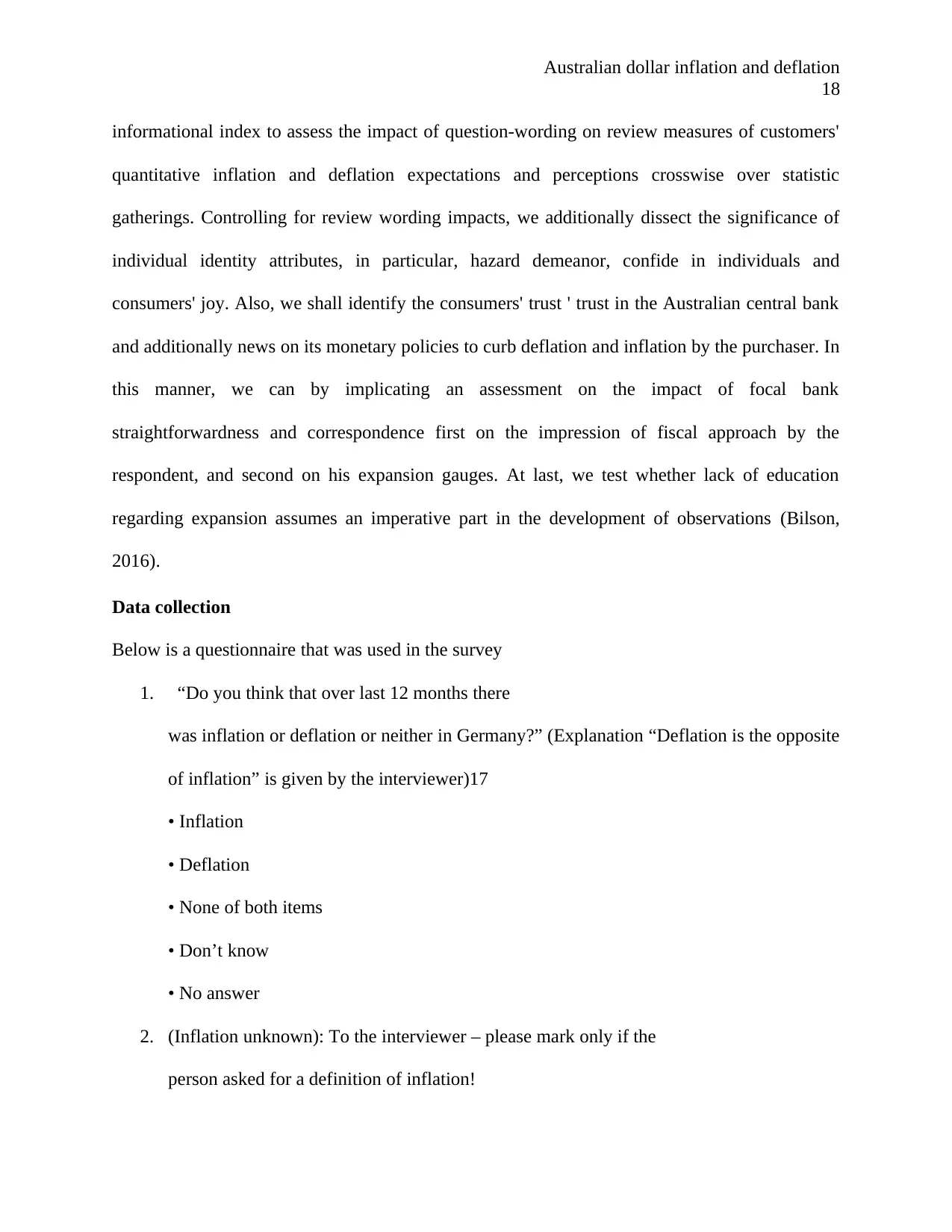
Australian dollar inflation and deflation
18
informational index to assess the impact of question-wording on review measures of customers'
quantitative inflation and deflation expectations and perceptions crosswise over statistic
gatherings. Controlling for review wording impacts, we additionally dissect the significance of
individual identity attributes, in particular, hazard demeanor, confide in individuals and
consumers' joy. Also, we shall identify the consumers' trust ' trust in the Australian central bank
and additionally news on its monetary policies to curb deflation and inflation by the purchaser. In
this manner, we can by implicating an assessment on the impact of focal bank
straightforwardness and correspondence first on the impression of fiscal approach by the
respondent, and second on his expansion gauges. At last, we test whether lack of education
regarding expansion assumes an imperative part in the development of observations (Bilson,
2016).
Data collection
Below is a questionnaire that was used in the survey
1. “Do you think that over last 12 months there
was inflation or deflation or neither in Germany?” (Explanation “Deflation is the opposite
of inflation” is given by the interviewer)17
• Inflation
• Deflation
• None of both items
• Don’t know
• No answer
2. (Inflation unknown): To the interviewer – please mark only if the
person asked for a definition of inflation!
18
informational index to assess the impact of question-wording on review measures of customers'
quantitative inflation and deflation expectations and perceptions crosswise over statistic
gatherings. Controlling for review wording impacts, we additionally dissect the significance of
individual identity attributes, in particular, hazard demeanor, confide in individuals and
consumers' joy. Also, we shall identify the consumers' trust ' trust in the Australian central bank
and additionally news on its monetary policies to curb deflation and inflation by the purchaser. In
this manner, we can by implicating an assessment on the impact of focal bank
straightforwardness and correspondence first on the impression of fiscal approach by the
respondent, and second on his expansion gauges. At last, we test whether lack of education
regarding expansion assumes an imperative part in the development of observations (Bilson,
2016).
Data collection
Below is a questionnaire that was used in the survey
1. “Do you think that over last 12 months there
was inflation or deflation or neither in Germany?” (Explanation “Deflation is the opposite
of inflation” is given by the interviewer)17
• Inflation
• Deflation
• None of both items
• Don’t know
• No answer
2. (Inflation unknown): To the interviewer – please mark only if the
person asked for a definition of inflation!
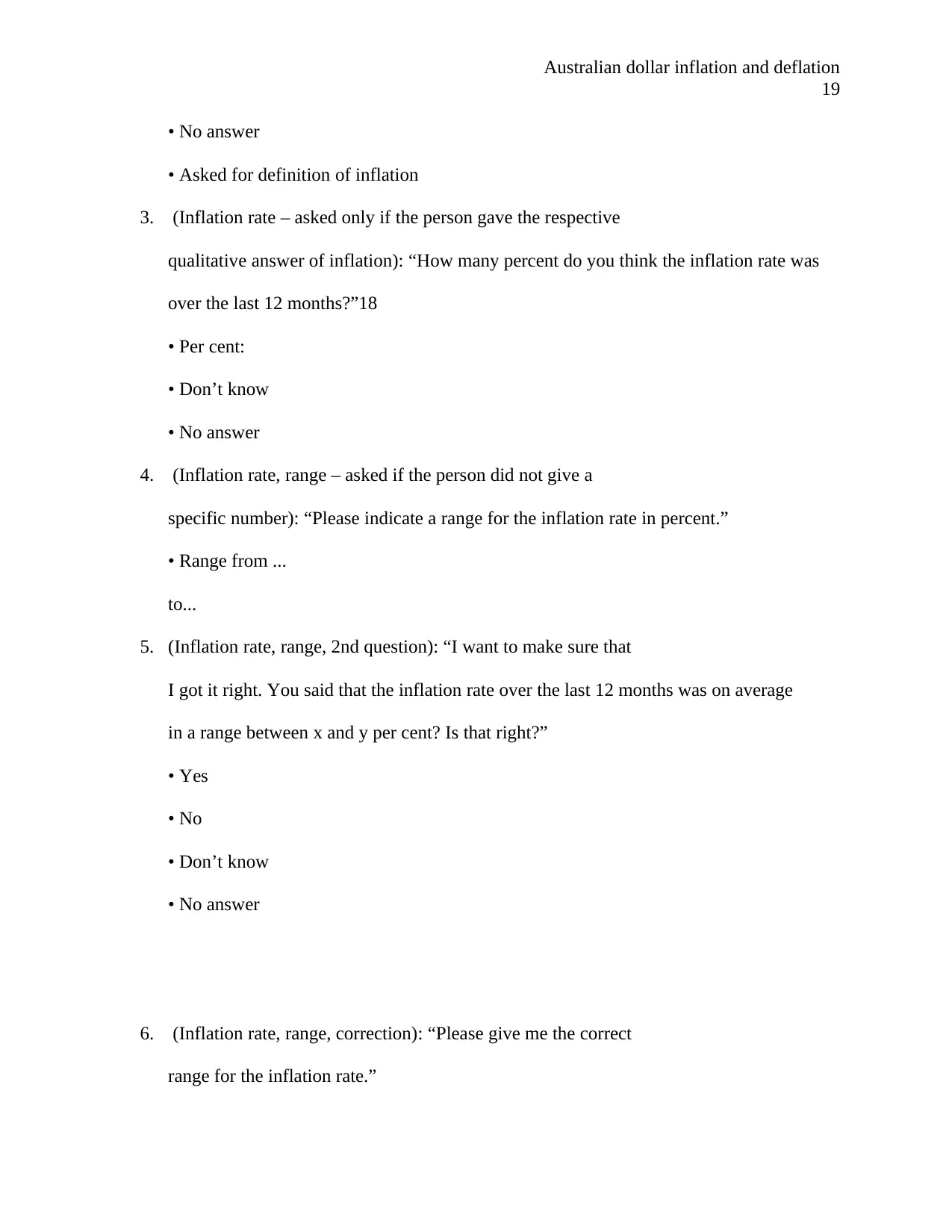
Australian dollar inflation and deflation
19
• No answer
• Asked for definition of inflation
3. (Inflation rate – asked only if the person gave the respective
qualitative answer of inflation): “How many percent do you think the inflation rate was
over the last 12 months?”18
• Per cent:
• Don’t know
• No answer
4. (Inflation rate, range – asked if the person did not give a
specific number): “Please indicate a range for the inflation rate in percent.”
• Range from ...
to...
5. (Inflation rate, range, 2nd question): “I want to make sure that
I got it right. You said that the inflation rate over the last 12 months was on average
in a range between x and y per cent? Is that right?”
• Yes
• No
• Don’t know
• No answer
6. (Inflation rate, range, correction): “Please give me the correct
range for the inflation rate.”
19
• No answer
• Asked for definition of inflation
3. (Inflation rate – asked only if the person gave the respective
qualitative answer of inflation): “How many percent do you think the inflation rate was
over the last 12 months?”18
• Per cent:
• Don’t know
• No answer
4. (Inflation rate, range – asked if the person did not give a
specific number): “Please indicate a range for the inflation rate in percent.”
• Range from ...
to...
5. (Inflation rate, range, 2nd question): “I want to make sure that
I got it right. You said that the inflation rate over the last 12 months was on average
in a range between x and y per cent? Is that right?”
• Yes
• No
• Don’t know
• No answer
6. (Inflation rate, range, correction): “Please give me the correct
range for the inflation rate.”
Paraphrase This Document
Need a fresh take? Get an instant paraphrase of this document with our AI Paraphraser
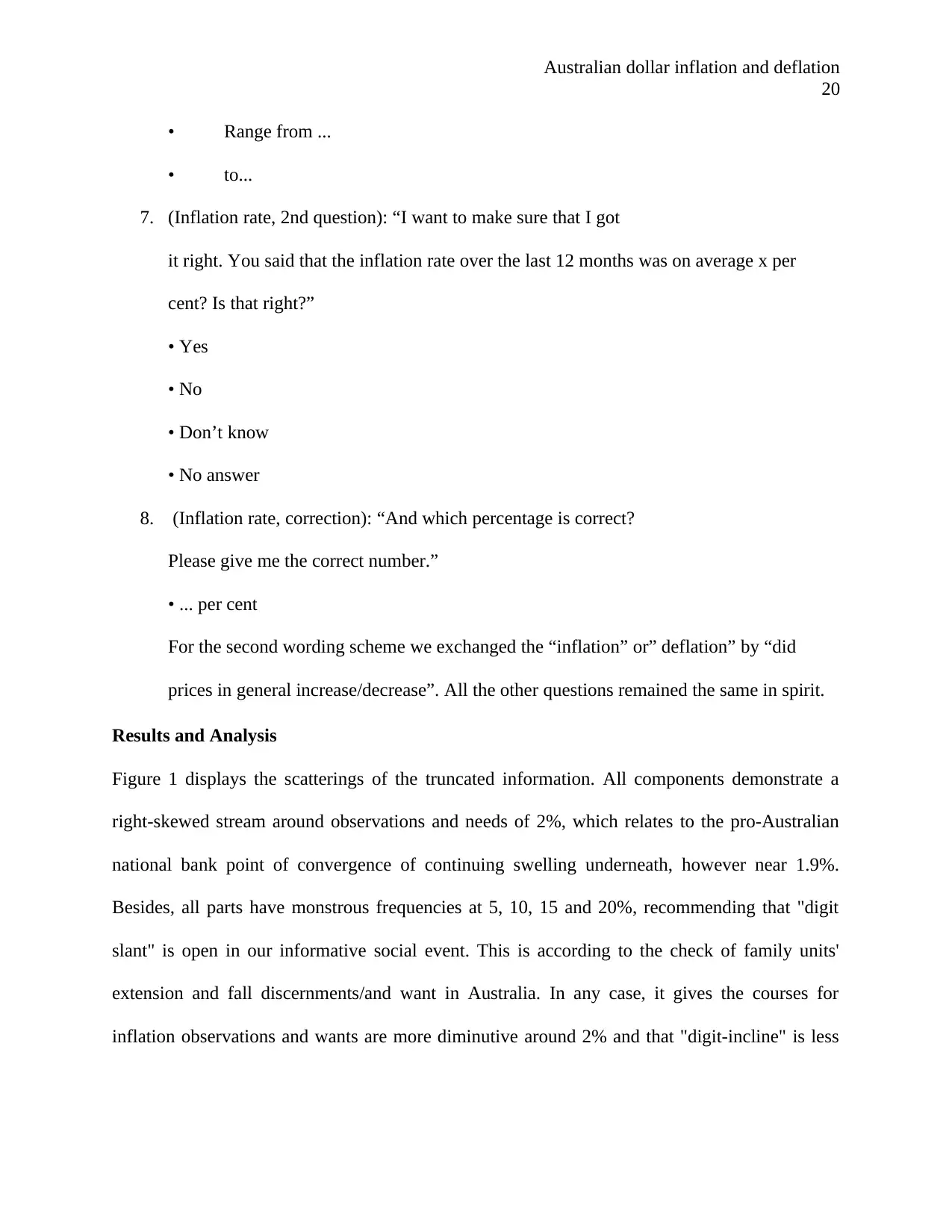
Australian dollar inflation and deflation
20
• Range from ...
• to...
7. (Inflation rate, 2nd question): “I want to make sure that I got
it right. You said that the inflation rate over the last 12 months was on average x per
cent? Is that right?”
• Yes
• No
• Don’t know
• No answer
8. (Inflation rate, correction): “And which percentage is correct?
Please give me the correct number.”
• ... per cent
For the second wording scheme we exchanged the “inflation” or” deflation” by “did
prices in general increase/decrease”. All the other questions remained the same in spirit.
Results and Analysis
Figure 1 displays the scatterings of the truncated information. All components demonstrate a
right-skewed stream around observations and needs of 2%, which relates to the pro-Australian
national bank point of convergence of continuing swelling underneath, however near 1.9%.
Besides, all parts have monstrous frequencies at 5, 10, 15 and 20%, recommending that "digit
slant" is open in our informative social event. This is according to the check of family units'
extension and fall discernments/and want in Australia. In any case, it gives the courses for
inflation observations and wants are more diminutive around 2% and that "digit-incline" is less
20
• Range from ...
• to...
7. (Inflation rate, 2nd question): “I want to make sure that I got
it right. You said that the inflation rate over the last 12 months was on average x per
cent? Is that right?”
• Yes
• No
• Don’t know
• No answer
8. (Inflation rate, correction): “And which percentage is correct?
Please give me the correct number.”
• ... per cent
For the second wording scheme we exchanged the “inflation” or” deflation” by “did
prices in general increase/decrease”. All the other questions remained the same in spirit.
Results and Analysis
Figure 1 displays the scatterings of the truncated information. All components demonstrate a
right-skewed stream around observations and needs of 2%, which relates to the pro-Australian
national bank point of convergence of continuing swelling underneath, however near 1.9%.
Besides, all parts have monstrous frequencies at 5, 10, 15 and 20%, recommending that "digit
slant" is open in our informative social event. This is according to the check of family units'
extension and fall discernments/and want in Australia. In any case, it gives the courses for
inflation observations and wants are more diminutive around 2% and that "digit-incline" is less
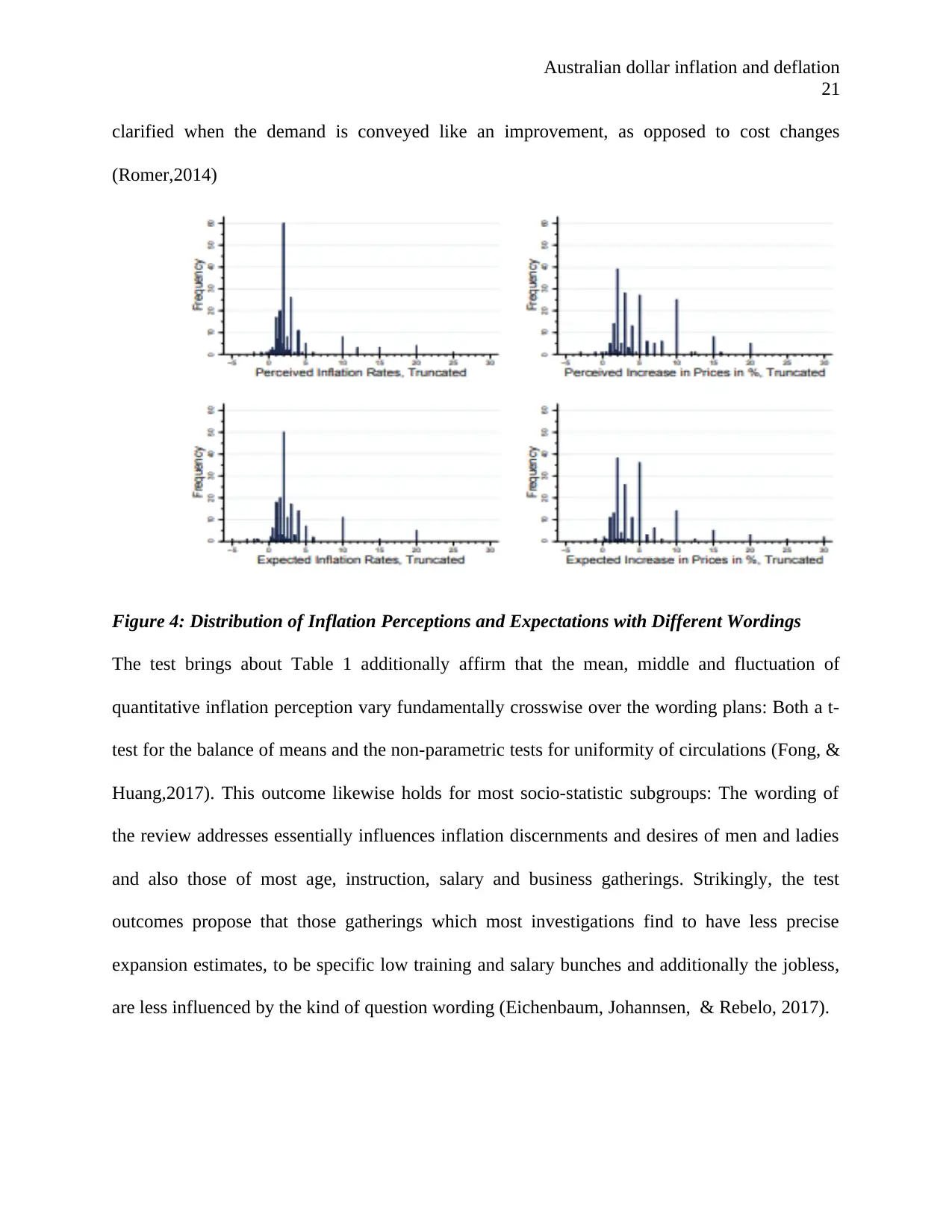
Australian dollar inflation and deflation
21
clarified when the demand is conveyed like an improvement, as opposed to cost changes
(Romer,2014)
Figure 4: Distribution of Inflation Perceptions and Expectations with Different Wordings
The test brings about Table 1 additionally affirm that the mean, middle and fluctuation of
quantitative inflation perception vary fundamentally crosswise over the wording plans: Both a t-
test for the balance of means and the non-parametric tests for uniformity of circulations (Fong, &
Huang,2017). This outcome likewise holds for most socio-statistic subgroups: The wording of
the review addresses essentially influences inflation discernments and desires of men and ladies
and also those of most age, instruction, salary and business gatherings. Strikingly, the test
outcomes propose that those gatherings which most investigations find to have less precise
expansion estimates, to be specific low training and salary bunches and additionally the jobless,
are less influenced by the kind of question wording (Eichenbaum, Johannsen, & Rebelo, 2017).
21
clarified when the demand is conveyed like an improvement, as opposed to cost changes
(Romer,2014)
Figure 4: Distribution of Inflation Perceptions and Expectations with Different Wordings
The test brings about Table 1 additionally affirm that the mean, middle and fluctuation of
quantitative inflation perception vary fundamentally crosswise over the wording plans: Both a t-
test for the balance of means and the non-parametric tests for uniformity of circulations (Fong, &
Huang,2017). This outcome likewise holds for most socio-statistic subgroups: The wording of
the review addresses essentially influences inflation discernments and desires of men and ladies
and also those of most age, instruction, salary and business gatherings. Strikingly, the test
outcomes propose that those gatherings which most investigations find to have less precise
expansion estimates, to be specific low training and salary bunches and additionally the jobless,
are less influenced by the kind of question wording (Eichenbaum, Johannsen, & Rebelo, 2017).
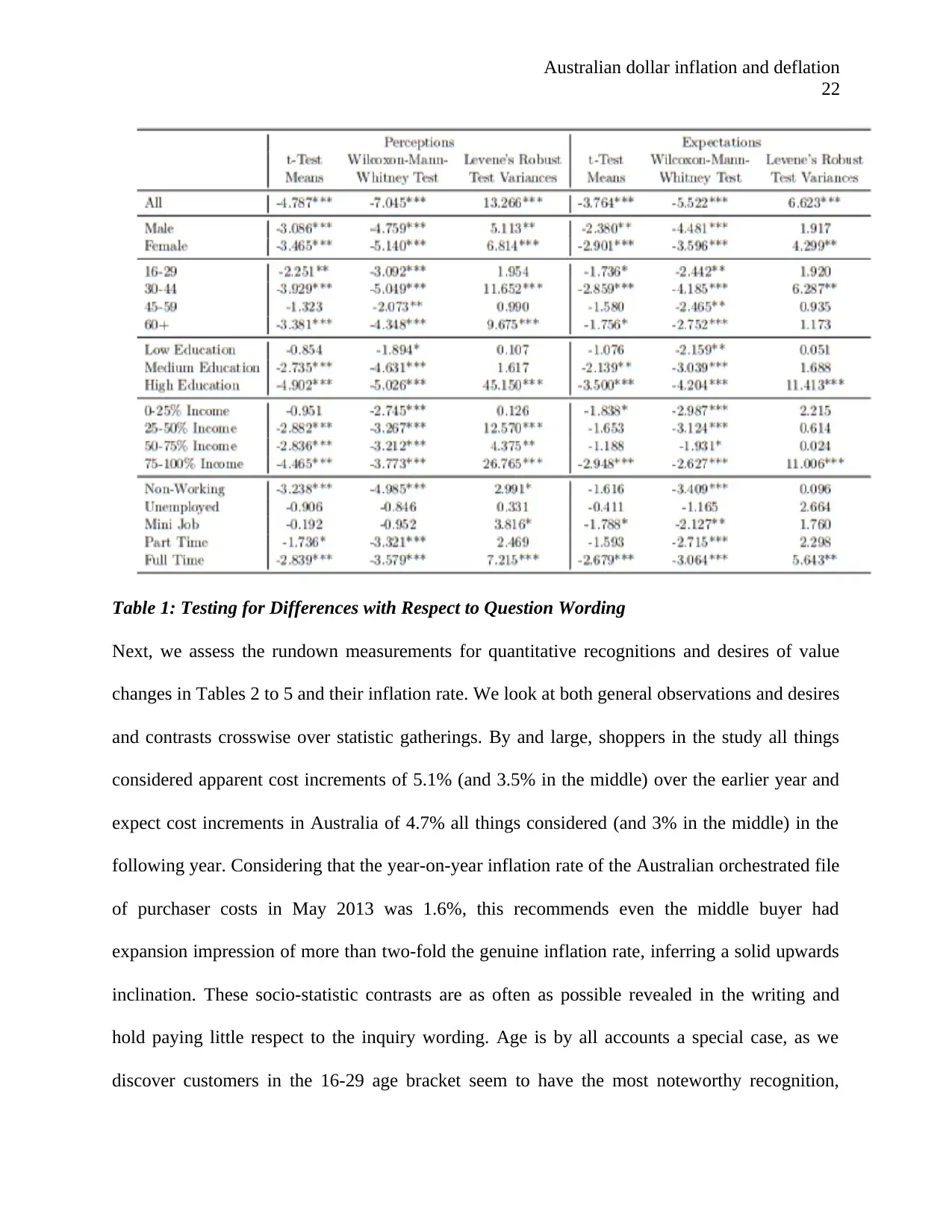
Australian dollar inflation and deflation
22
Table 1: Testing for Differences with Respect to Question Wording
Next, we assess the rundown measurements for quantitative recognitions and desires of value
changes in Tables 2 to 5 and their inflation rate. We look at both general observations and desires
and contrasts crosswise over statistic gatherings. By and large, shoppers in the study all things
considered apparent cost increments of 5.1% (and 3.5% in the middle) over the earlier year and
expect cost increments in Australia of 4.7% all things considered (and 3% in the middle) in the
following year. Considering that the year-on-year inflation rate of the Australian orchestrated file
of purchaser costs in May 2013 was 1.6%, this recommends even the middle buyer had
expansion impression of more than two-fold the genuine inflation rate, inferring a solid upwards
inclination. These socio-statistic contrasts are as often as possible revealed in the writing and
hold paying little respect to the inquiry wording. Age is by all accounts a special case, as we
discover customers in the 16-29 age bracket seem to have the most noteworthy recognition,
22
Table 1: Testing for Differences with Respect to Question Wording
Next, we assess the rundown measurements for quantitative recognitions and desires of value
changes in Tables 2 to 5 and their inflation rate. We look at both general observations and desires
and contrasts crosswise over statistic gatherings. By and large, shoppers in the study all things
considered apparent cost increments of 5.1% (and 3.5% in the middle) over the earlier year and
expect cost increments in Australia of 4.7% all things considered (and 3% in the middle) in the
following year. Considering that the year-on-year inflation rate of the Australian orchestrated file
of purchaser costs in May 2013 was 1.6%, this recommends even the middle buyer had
expansion impression of more than two-fold the genuine inflation rate, inferring a solid upwards
inclination. These socio-statistic contrasts are as often as possible revealed in the writing and
hold paying little respect to the inquiry wording. Age is by all accounts a special case, as we
discover customers in the 16-29 age bracket seem to have the most noteworthy recognition,
Secure Best Marks with AI Grader
Need help grading? Try our AI Grader for instant feedback on your assignments.
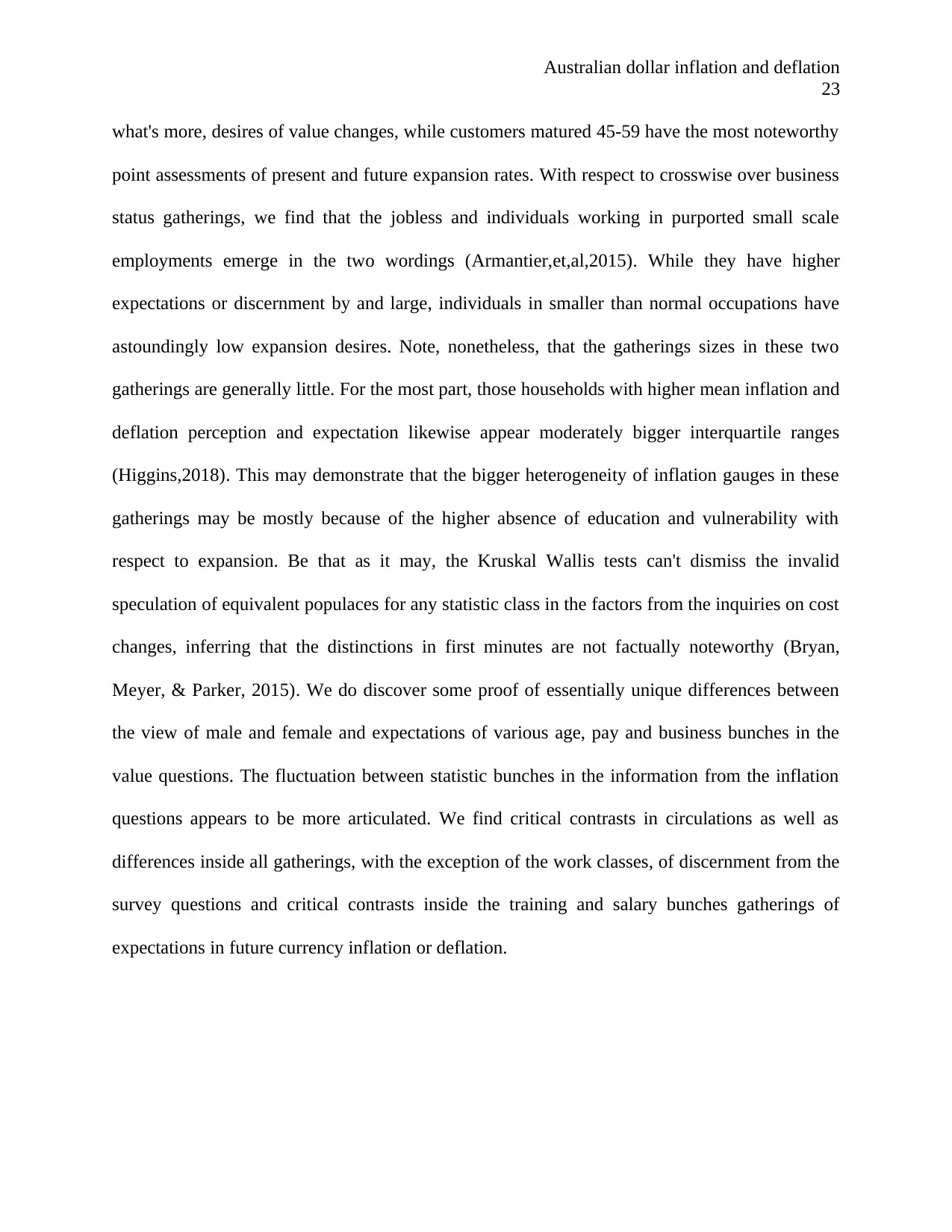
Australian dollar inflation and deflation
23
what's more, desires of value changes, while customers matured 45-59 have the most noteworthy
point assessments of present and future expansion rates. With respect to crosswise over business
status gatherings, we find that the jobless and individuals working in purported small scale
employments emerge in the two wordings (Armantier,et,al,2015). While they have higher
expectations or discernment by and large, individuals in smaller than normal occupations have
astoundingly low expansion desires. Note, nonetheless, that the gatherings sizes in these two
gatherings are generally little. For the most part, those households with higher mean inflation and
deflation perception and expectation likewise appear moderately bigger interquartile ranges
(Higgins,2018). This may demonstrate that the bigger heterogeneity of inflation gauges in these
gatherings may be mostly because of the higher absence of education and vulnerability with
respect to expansion. Be that as it may, the Kruskal Wallis tests can't dismiss the invalid
speculation of equivalent populaces for any statistic class in the factors from the inquiries on cost
changes, inferring that the distinctions in first minutes are not factually noteworthy (Bryan,
Meyer, & Parker, 2015). We do discover some proof of essentially unique differences between
the view of male and female and expectations of various age, pay and business bunches in the
value questions. The fluctuation between statistic bunches in the information from the inflation
questions appears to be more articulated. We find critical contrasts in circulations as well as
differences inside all gatherings, with the exception of the work classes, of discernment from the
survey questions and critical contrasts inside the training and salary bunches gatherings of
expectations in future currency inflation or deflation.
23
what's more, desires of value changes, while customers matured 45-59 have the most noteworthy
point assessments of present and future expansion rates. With respect to crosswise over business
status gatherings, we find that the jobless and individuals working in purported small scale
employments emerge in the two wordings (Armantier,et,al,2015). While they have higher
expectations or discernment by and large, individuals in smaller than normal occupations have
astoundingly low expansion desires. Note, nonetheless, that the gatherings sizes in these two
gatherings are generally little. For the most part, those households with higher mean inflation and
deflation perception and expectation likewise appear moderately bigger interquartile ranges
(Higgins,2018). This may demonstrate that the bigger heterogeneity of inflation gauges in these
gatherings may be mostly because of the higher absence of education and vulnerability with
respect to expansion. Be that as it may, the Kruskal Wallis tests can't dismiss the invalid
speculation of equivalent populaces for any statistic class in the factors from the inquiries on cost
changes, inferring that the distinctions in first minutes are not factually noteworthy (Bryan,
Meyer, & Parker, 2015). We do discover some proof of essentially unique differences between
the view of male and female and expectations of various age, pay and business bunches in the
value questions. The fluctuation between statistic bunches in the information from the inflation
questions appears to be more articulated. We find critical contrasts in circulations as well as
differences inside all gatherings, with the exception of the work classes, of discernment from the
survey questions and critical contrasts inside the training and salary bunches gatherings of
expectations in future currency inflation or deflation.
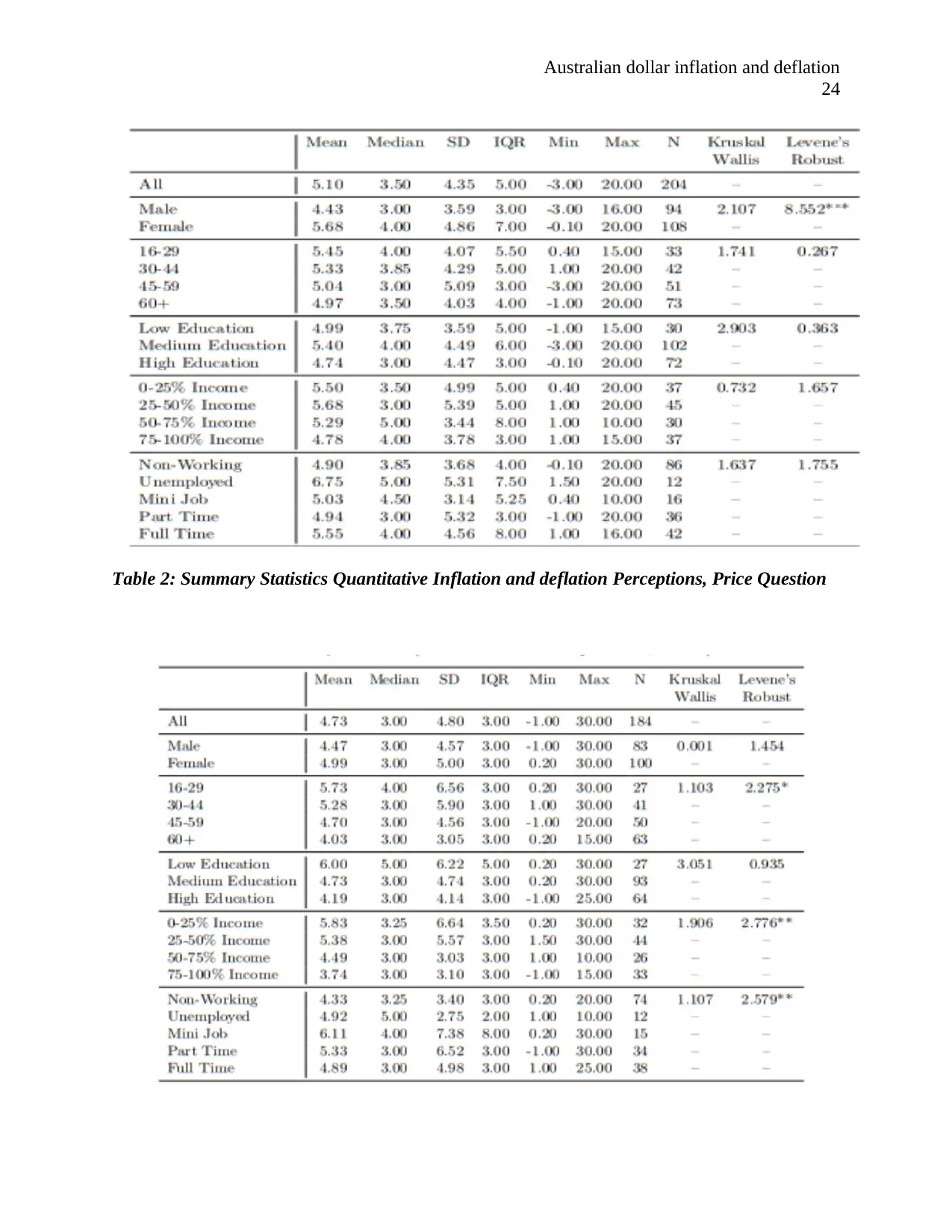
Australian dollar inflation and deflation
24
Table 2: Summary Statistics Quantitative Inflation and deflation Perceptions, Price Question
24
Table 2: Summary Statistics Quantitative Inflation and deflation Perceptions, Price Question
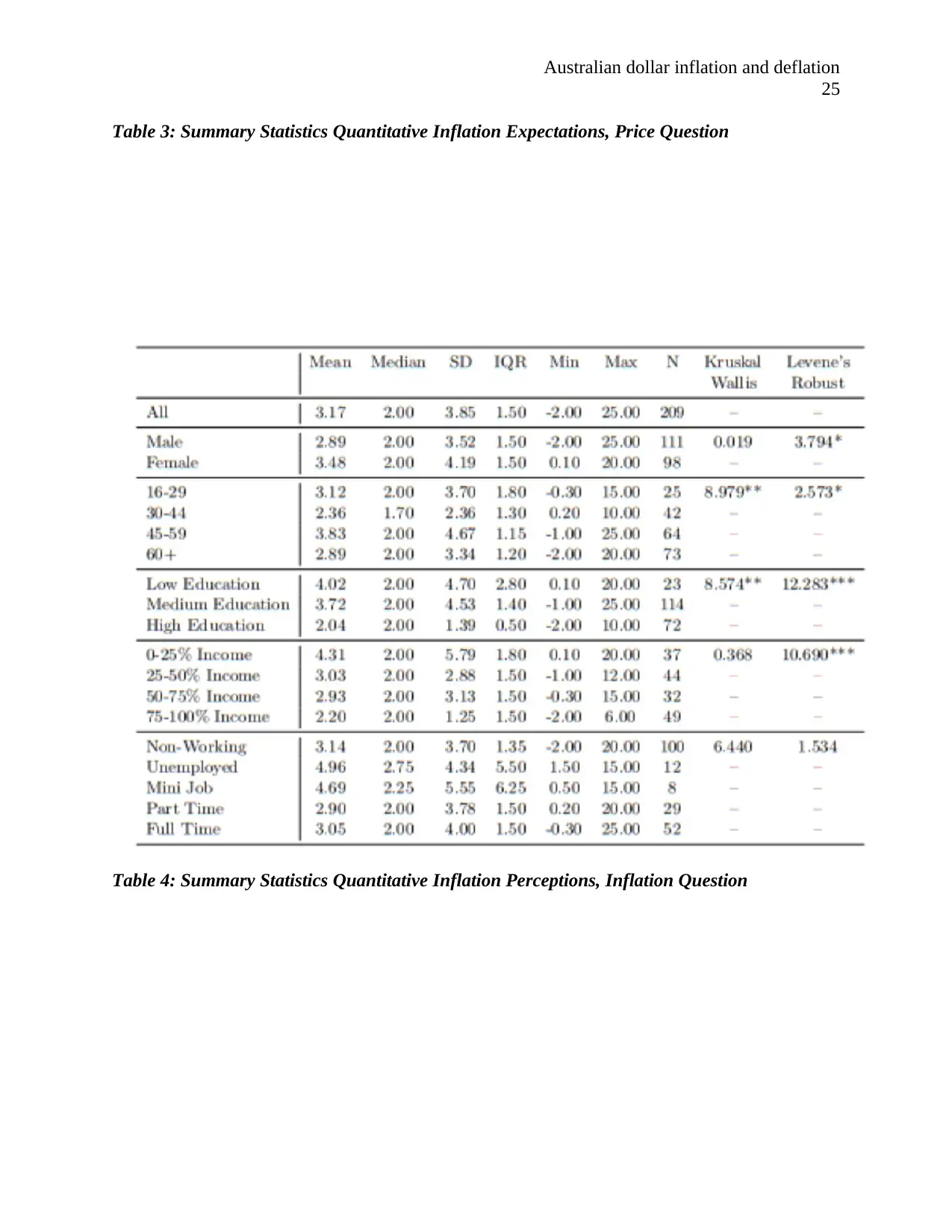
Australian dollar inflation and deflation
25
Table 3: Summary Statistics Quantitative Inflation Expectations, Price Question
Table 4: Summary Statistics Quantitative Inflation Perceptions, Inflation Question
25
Table 3: Summary Statistics Quantitative Inflation Expectations, Price Question
Table 4: Summary Statistics Quantitative Inflation Perceptions, Inflation Question
Paraphrase This Document
Need a fresh take? Get an instant paraphrase of this document with our AI Paraphraser
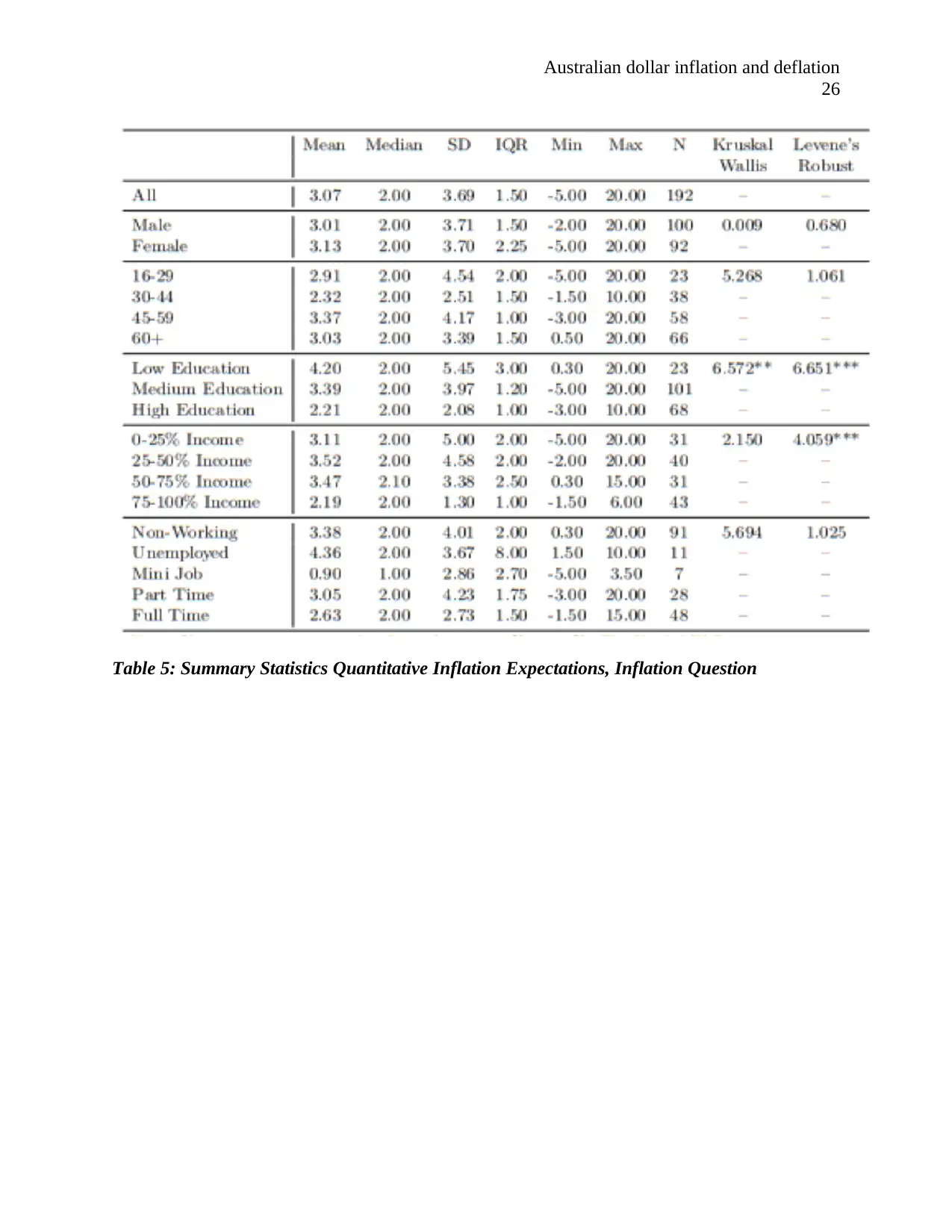
Australian dollar inflation and deflation
26
Table 5: Summary Statistics Quantitative Inflation Expectations, Inflation Question
26
Table 5: Summary Statistics Quantitative Inflation Expectations, Inflation Question
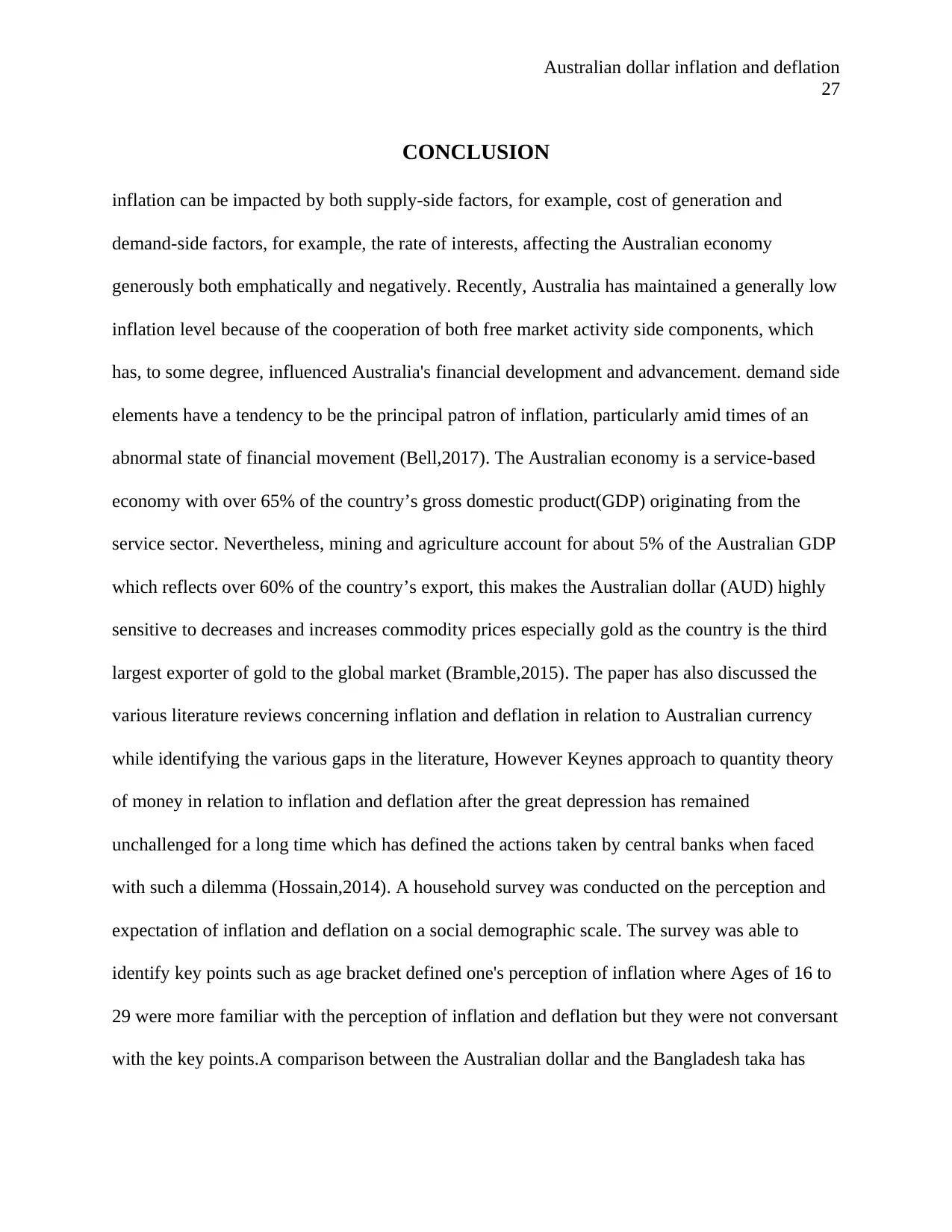
Australian dollar inflation and deflation
27
CONCLUSION
inflation can be impacted by both supply-side factors, for example, cost of generation and
demand-side factors, for example, the rate of interests, affecting the Australian economy
generously both emphatically and negatively. Recently, Australia has maintained a generally low
inflation level because of the cooperation of both free market activity side components, which
has, to some degree, influenced Australia's financial development and advancement. demand side
elements have a tendency to be the principal patron of inflation, particularly amid times of an
abnormal state of financial movement (Bell,2017). The Australian economy is a service-based
economy with over 65% of the country’s gross domestic product(GDP) originating from the
service sector. Nevertheless, mining and agriculture account for about 5% of the Australian GDP
which reflects over 60% of the country’s export, this makes the Australian dollar (AUD) highly
sensitive to decreases and increases commodity prices especially gold as the country is the third
largest exporter of gold to the global market (Bramble,2015). The paper has also discussed the
various literature reviews concerning inflation and deflation in relation to Australian currency
while identifying the various gaps in the literature, However Keynes approach to quantity theory
of money in relation to inflation and deflation after the great depression has remained
unchallenged for a long time which has defined the actions taken by central banks when faced
with such a dilemma (Hossain,2014). A household survey was conducted on the perception and
expectation of inflation and deflation on a social demographic scale. The survey was able to
identify key points such as age bracket defined one's perception of inflation where Ages of 16 to
29 were more familiar with the perception of inflation and deflation but they were not conversant
with the key points.A comparison between the Australian dollar and the Bangladesh taka has
27
CONCLUSION
inflation can be impacted by both supply-side factors, for example, cost of generation and
demand-side factors, for example, the rate of interests, affecting the Australian economy
generously both emphatically and negatively. Recently, Australia has maintained a generally low
inflation level because of the cooperation of both free market activity side components, which
has, to some degree, influenced Australia's financial development and advancement. demand side
elements have a tendency to be the principal patron of inflation, particularly amid times of an
abnormal state of financial movement (Bell,2017). The Australian economy is a service-based
economy with over 65% of the country’s gross domestic product(GDP) originating from the
service sector. Nevertheless, mining and agriculture account for about 5% of the Australian GDP
which reflects over 60% of the country’s export, this makes the Australian dollar (AUD) highly
sensitive to decreases and increases commodity prices especially gold as the country is the third
largest exporter of gold to the global market (Bramble,2015). The paper has also discussed the
various literature reviews concerning inflation and deflation in relation to Australian currency
while identifying the various gaps in the literature, However Keynes approach to quantity theory
of money in relation to inflation and deflation after the great depression has remained
unchallenged for a long time which has defined the actions taken by central banks when faced
with such a dilemma (Hossain,2014). A household survey was conducted on the perception and
expectation of inflation and deflation on a social demographic scale. The survey was able to
identify key points such as age bracket defined one's perception of inflation where Ages of 16 to
29 were more familiar with the perception of inflation and deflation but they were not conversant
with the key points.A comparison between the Australian dollar and the Bangladesh taka has

Australian dollar inflation and deflation
28
been reviewed in this paper where it determined the economic strength of the two currencies by
putting them, into perspective while focusing on the rate of inflation on the two currencies
28
been reviewed in this paper where it determined the economic strength of the two currencies by
putting them, into perspective while focusing on the rate of inflation on the two currencies
Secure Best Marks with AI Grader
Need help grading? Try our AI Grader for instant feedback on your assignments.
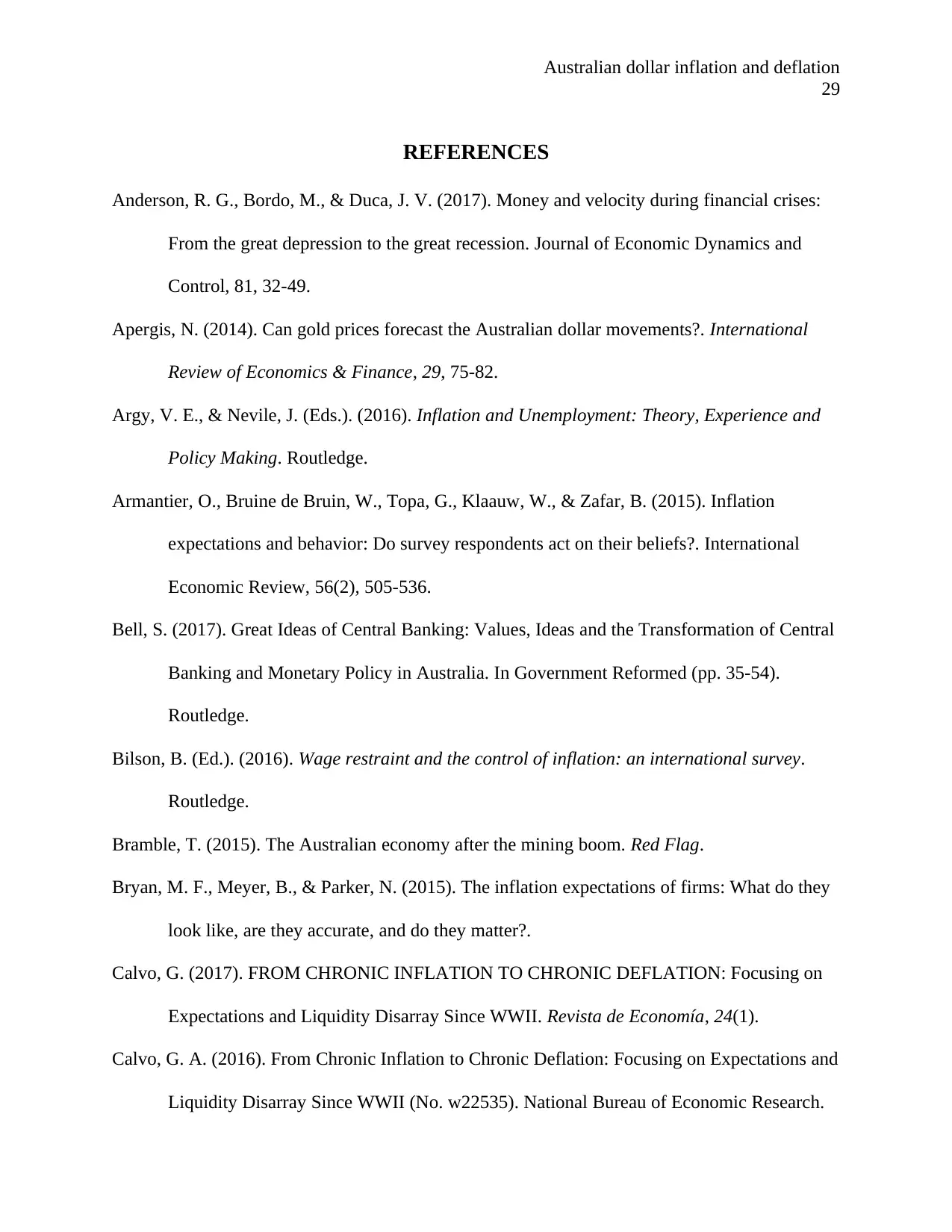
Australian dollar inflation and deflation
29
REFERENCES
Anderson, R. G., Bordo, M., & Duca, J. V. (2017). Money and velocity during financial crises:
From the great depression to the great recession. Journal of Economic Dynamics and
Control, 81, 32-49.
Apergis, N. (2014). Can gold prices forecast the Australian dollar movements?. International
Review of Economics & Finance, 29, 75-82.
Argy, V. E., & Nevile, J. (Eds.). (2016). Inflation and Unemployment: Theory, Experience and
Policy Making. Routledge.
Armantier, O., Bruine de Bruin, W., Topa, G., Klaauw, W., & Zafar, B. (2015). Inflation
expectations and behavior: Do survey respondents act on their beliefs?. International
Economic Review, 56(2), 505-536.
Bell, S. (2017). Great Ideas of Central Banking: Values, Ideas and the Transformation of Central
Banking and Monetary Policy in Australia. In Government Reformed (pp. 35-54).
Routledge.
Bilson, B. (Ed.). (2016). Wage restraint and the control of inflation: an international survey.
Routledge.
Bramble, T. (2015). The Australian economy after the mining boom. Red Flag.
Bryan, M. F., Meyer, B., & Parker, N. (2015). The inflation expectations of firms: What do they
look like, are they accurate, and do they matter?.
Calvo, G. (2017). FROM CHRONIC INFLATION TO CHRONIC DEFLATION: Focusing on
Expectations and Liquidity Disarray Since WWII. Revista de Economía, 24(1).
Calvo, G. A. (2016). From Chronic Inflation to Chronic Deflation: Focusing on Expectations and
Liquidity Disarray Since WWII (No. w22535). National Bureau of Economic Research.
29
REFERENCES
Anderson, R. G., Bordo, M., & Duca, J. V. (2017). Money and velocity during financial crises:
From the great depression to the great recession. Journal of Economic Dynamics and
Control, 81, 32-49.
Apergis, N. (2014). Can gold prices forecast the Australian dollar movements?. International
Review of Economics & Finance, 29, 75-82.
Argy, V. E., & Nevile, J. (Eds.). (2016). Inflation and Unemployment: Theory, Experience and
Policy Making. Routledge.
Armantier, O., Bruine de Bruin, W., Topa, G., Klaauw, W., & Zafar, B. (2015). Inflation
expectations and behavior: Do survey respondents act on their beliefs?. International
Economic Review, 56(2), 505-536.
Bell, S. (2017). Great Ideas of Central Banking: Values, Ideas and the Transformation of Central
Banking and Monetary Policy in Australia. In Government Reformed (pp. 35-54).
Routledge.
Bilson, B. (Ed.). (2016). Wage restraint and the control of inflation: an international survey.
Routledge.
Bramble, T. (2015). The Australian economy after the mining boom. Red Flag.
Bryan, M. F., Meyer, B., & Parker, N. (2015). The inflation expectations of firms: What do they
look like, are they accurate, and do they matter?.
Calvo, G. (2017). FROM CHRONIC INFLATION TO CHRONIC DEFLATION: Focusing on
Expectations and Liquidity Disarray Since WWII. Revista de Economía, 24(1).
Calvo, G. A. (2016). From Chronic Inflation to Chronic Deflation: Focusing on Expectations and
Liquidity Disarray Since WWII (No. w22535). National Bureau of Economic Research.
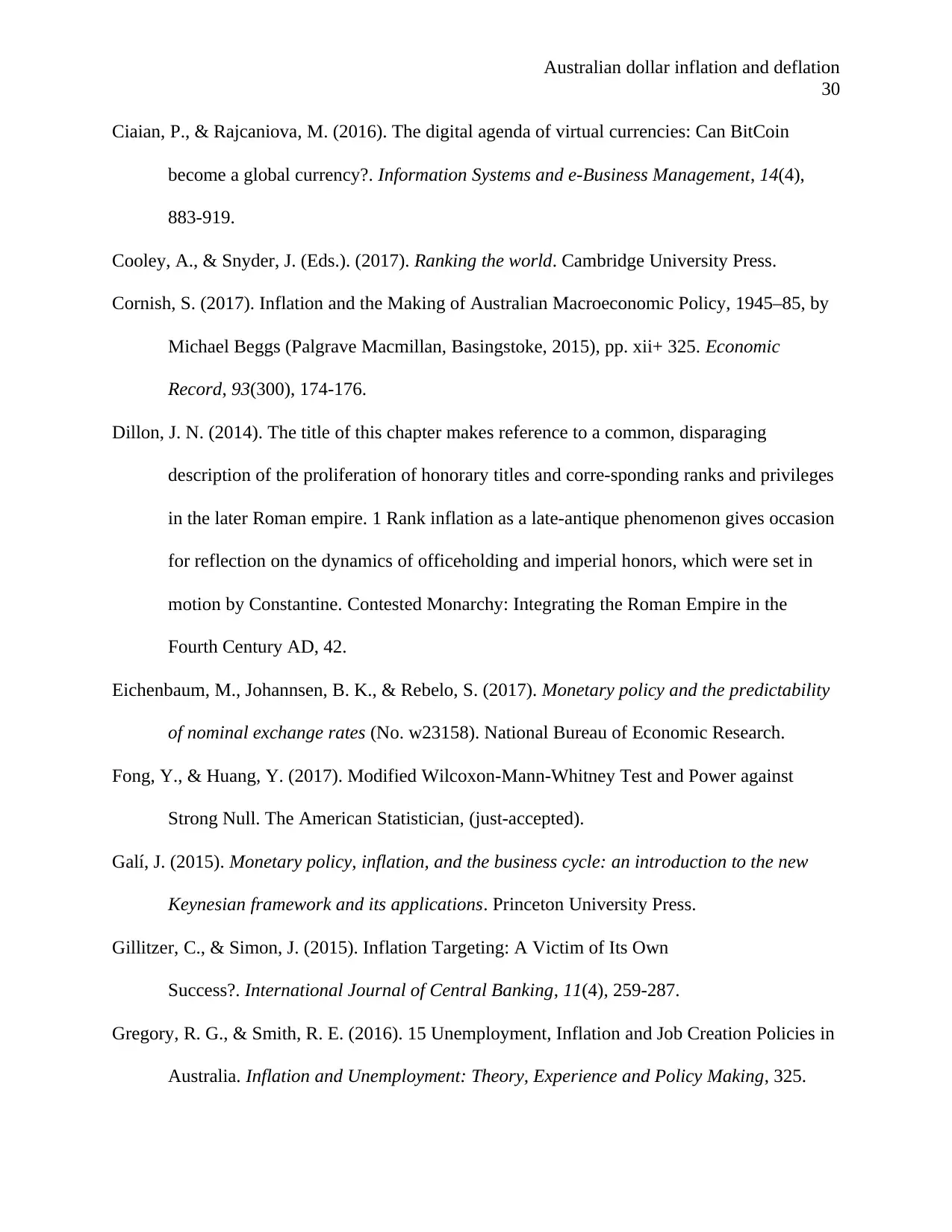
Australian dollar inflation and deflation
30
Ciaian, P., & Rajcaniova, M. (2016). The digital agenda of virtual currencies: Can BitCoin
become a global currency?. Information Systems and e-Business Management, 14(4),
883-919.
Cooley, A., & Snyder, J. (Eds.). (2017). Ranking the world. Cambridge University Press.
Cornish, S. (2017). Inflation and the Making of Australian Macroeconomic Policy, 1945–85, by
Michael Beggs (Palgrave Macmillan, Basingstoke, 2015), pp. xii+ 325. Economic
Record, 93(300), 174-176.
Dillon, J. N. (2014). The title of this chapter makes reference to a common, disparaging
description of the proliferation of honorary titles and corre-sponding ranks and privileges
in the later Roman empire. 1 Rank inflation as a late-antique phenomenon gives occasion
for reflection on the dynamics of officeholding and imperial honors, which were set in
motion by Constantine. Contested Monarchy: Integrating the Roman Empire in the
Fourth Century AD, 42.
Eichenbaum, M., Johannsen, B. K., & Rebelo, S. (2017). Monetary policy and the predictability
of nominal exchange rates (No. w23158). National Bureau of Economic Research.
Fong, Y., & Huang, Y. (2017). Modified Wilcoxon-Mann-Whitney Test and Power against
Strong Null. The American Statistician, (just-accepted).
Galí, J. (2015). Monetary policy, inflation, and the business cycle: an introduction to the new
Keynesian framework and its applications. Princeton University Press.
Gillitzer, C., & Simon, J. (2015). Inflation Targeting: A Victim of Its Own
Success?. International Journal of Central Banking, 11(4), 259-287.
Gregory, R. G., & Smith, R. E. (2016). 15 Unemployment, Inflation and Job Creation Policies in
Australia. Inflation and Unemployment: Theory, Experience and Policy Making, 325.
30
Ciaian, P., & Rajcaniova, M. (2016). The digital agenda of virtual currencies: Can BitCoin
become a global currency?. Information Systems and e-Business Management, 14(4),
883-919.
Cooley, A., & Snyder, J. (Eds.). (2017). Ranking the world. Cambridge University Press.
Cornish, S. (2017). Inflation and the Making of Australian Macroeconomic Policy, 1945–85, by
Michael Beggs (Palgrave Macmillan, Basingstoke, 2015), pp. xii+ 325. Economic
Record, 93(300), 174-176.
Dillon, J. N. (2014). The title of this chapter makes reference to a common, disparaging
description of the proliferation of honorary titles and corre-sponding ranks and privileges
in the later Roman empire. 1 Rank inflation as a late-antique phenomenon gives occasion
for reflection on the dynamics of officeholding and imperial honors, which were set in
motion by Constantine. Contested Monarchy: Integrating the Roman Empire in the
Fourth Century AD, 42.
Eichenbaum, M., Johannsen, B. K., & Rebelo, S. (2017). Monetary policy and the predictability
of nominal exchange rates (No. w23158). National Bureau of Economic Research.
Fong, Y., & Huang, Y. (2017). Modified Wilcoxon-Mann-Whitney Test and Power against
Strong Null. The American Statistician, (just-accepted).
Galí, J. (2015). Monetary policy, inflation, and the business cycle: an introduction to the new
Keynesian framework and its applications. Princeton University Press.
Gillitzer, C., & Simon, J. (2015). Inflation Targeting: A Victim of Its Own
Success?. International Journal of Central Banking, 11(4), 259-287.
Gregory, R. G., & Smith, R. E. (2016). 15 Unemployment, Inflation and Job Creation Policies in
Australia. Inflation and Unemployment: Theory, Experience and Policy Making, 325.
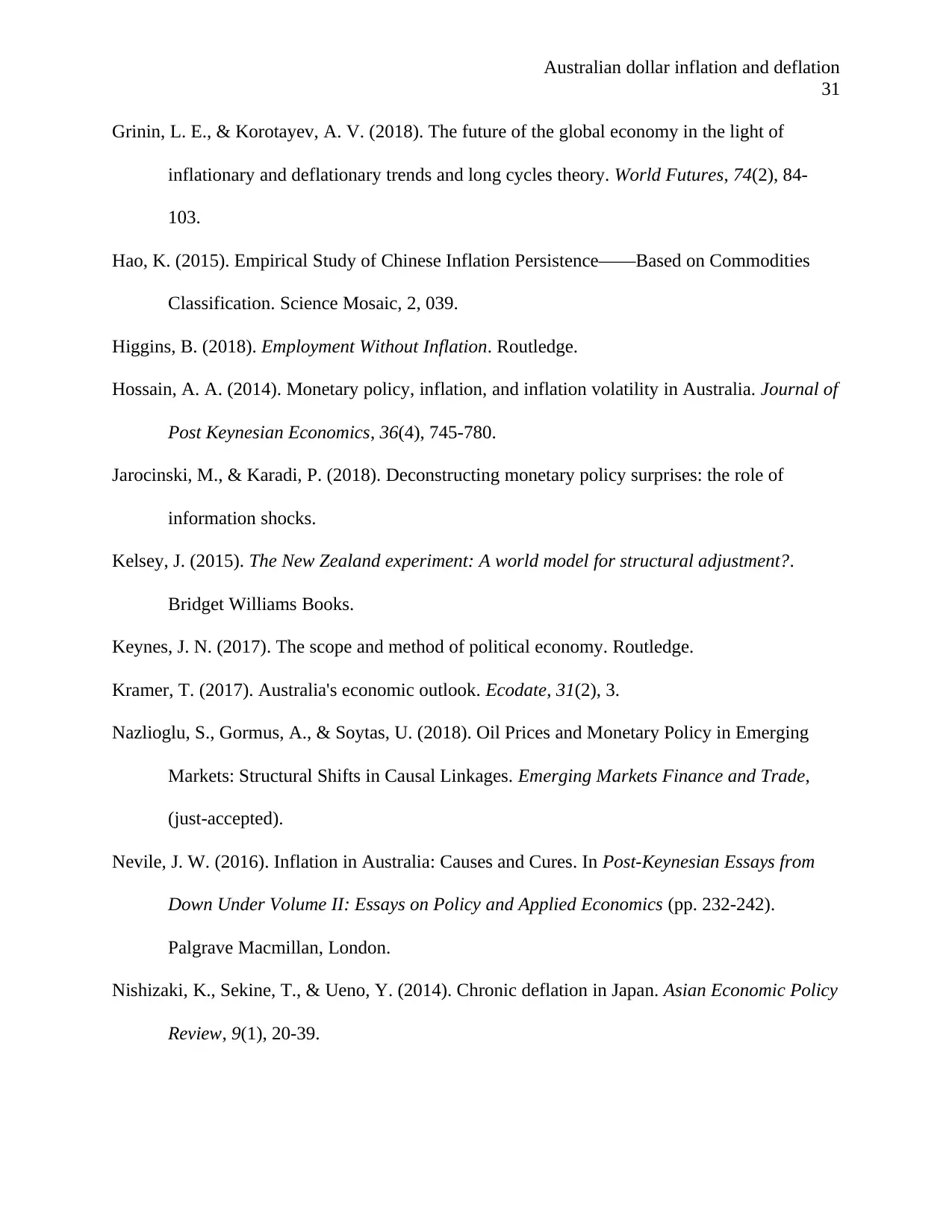
Australian dollar inflation and deflation
31
Grinin, L. E., & Korotayev, A. V. (2018). The future of the global economy in the light of
inflationary and deflationary trends and long cycles theory. World Futures, 74(2), 84-
103.
Hao, K. (2015). Empirical Study of Chinese Inflation Persistence——Based on Commodities
Classification. Science Mosaic, 2, 039.
Higgins, B. (2018). Employment Without Inflation. Routledge.
Hossain, A. A. (2014). Monetary policy, inflation, and inflation volatility in Australia. Journal of
Post Keynesian Economics, 36(4), 745-780.
Jarocinski, M., & Karadi, P. (2018). Deconstructing monetary policy surprises: the role of
information shocks.
Kelsey, J. (2015). The New Zealand experiment: A world model for structural adjustment?.
Bridget Williams Books.
Keynes, J. N. (2017). The scope and method of political economy. Routledge.
Kramer, T. (2017). Australia's economic outlook. Ecodate, 31(2), 3.
Nazlioglu, S., Gormus, A., & Soytas, U. (2018). Oil Prices and Monetary Policy in Emerging
Markets: Structural Shifts in Causal Linkages. Emerging Markets Finance and Trade,
(just-accepted).
Nevile, J. W. (2016). Inflation in Australia: Causes and Cures. In Post-Keynesian Essays from
Down Under Volume II: Essays on Policy and Applied Economics (pp. 232-242).
Palgrave Macmillan, London.
Nishizaki, K., Sekine, T., & Ueno, Y. (2014). Chronic deflation in Japan. Asian Economic Policy
Review, 9(1), 20-39.
31
Grinin, L. E., & Korotayev, A. V. (2018). The future of the global economy in the light of
inflationary and deflationary trends and long cycles theory. World Futures, 74(2), 84-
103.
Hao, K. (2015). Empirical Study of Chinese Inflation Persistence——Based on Commodities
Classification. Science Mosaic, 2, 039.
Higgins, B. (2018). Employment Without Inflation. Routledge.
Hossain, A. A. (2014). Monetary policy, inflation, and inflation volatility in Australia. Journal of
Post Keynesian Economics, 36(4), 745-780.
Jarocinski, M., & Karadi, P. (2018). Deconstructing monetary policy surprises: the role of
information shocks.
Kelsey, J. (2015). The New Zealand experiment: A world model for structural adjustment?.
Bridget Williams Books.
Keynes, J. N. (2017). The scope and method of political economy. Routledge.
Kramer, T. (2017). Australia's economic outlook. Ecodate, 31(2), 3.
Nazlioglu, S., Gormus, A., & Soytas, U. (2018). Oil Prices and Monetary Policy in Emerging
Markets: Structural Shifts in Causal Linkages. Emerging Markets Finance and Trade,
(just-accepted).
Nevile, J. W. (2016). Inflation in Australia: Causes and Cures. In Post-Keynesian Essays from
Down Under Volume II: Essays on Policy and Applied Economics (pp. 232-242).
Palgrave Macmillan, London.
Nishizaki, K., Sekine, T., & Ueno, Y. (2014). Chronic deflation in Japan. Asian Economic Policy
Review, 9(1), 20-39.
Paraphrase This Document
Need a fresh take? Get an instant paraphrase of this document with our AI Paraphraser

Australian dollar inflation and deflation
32
Pentecôte, J. S., & Rondeau, F. (2015). Trade spillovers on output growth during the 2008
financial crisis. International Economics, 143, 36-47.
Regnier, P. (2017). Small and Medium Enterprises in Distress: Thailand, the East Asian Crisis
and Beyond: Thailand, the East Asian Crisis and Beyond. Routledge.
Rojas-Suarez, L. (2015). Emerging Market Macroeconomic Resilience to External Shocks:
Today versus Pre–Global Crisis.
Romer, C. D. (2014). It takes a regime shift: recent developments in Japanese monetary policy
through the lens of the Great Depression. NBER Macroeconomics Annual, 28(1), 383-
400.
Su, C. W., Yu, H., Chang, H. L., & Li, X. L. (2017). How does inflation determine inflation
uncertainty? A Chinese perspective. Quality & Quantity, 51(3), 1417-1434.
Sumon, K. K., & Miyan, M. S. (2017). Inflation and Economic Growth: An Empirical Evidence
of Bangladesh (1986-2016). International Journal of Economics and Financial
Issues, 7(5), 454-464.
Watanabe, K., & Watanabe, T. (2018). Why Has Japan Failed to Escape from Deflation?. Asian
Economic Policy Review, 13(1), 23-41.
Wray, L. R. (2015). Inflation and Sovereign Currencies. In Modern Money Theory (pp. 248-269).
Palgrave Macmillan, London.
32
Pentecôte, J. S., & Rondeau, F. (2015). Trade spillovers on output growth during the 2008
financial crisis. International Economics, 143, 36-47.
Regnier, P. (2017). Small and Medium Enterprises in Distress: Thailand, the East Asian Crisis
and Beyond: Thailand, the East Asian Crisis and Beyond. Routledge.
Rojas-Suarez, L. (2015). Emerging Market Macroeconomic Resilience to External Shocks:
Today versus Pre–Global Crisis.
Romer, C. D. (2014). It takes a regime shift: recent developments in Japanese monetary policy
through the lens of the Great Depression. NBER Macroeconomics Annual, 28(1), 383-
400.
Su, C. W., Yu, H., Chang, H. L., & Li, X. L. (2017). How does inflation determine inflation
uncertainty? A Chinese perspective. Quality & Quantity, 51(3), 1417-1434.
Sumon, K. K., & Miyan, M. S. (2017). Inflation and Economic Growth: An Empirical Evidence
of Bangladesh (1986-2016). International Journal of Economics and Financial
Issues, 7(5), 454-464.
Watanabe, K., & Watanabe, T. (2018). Why Has Japan Failed to Escape from Deflation?. Asian
Economic Policy Review, 13(1), 23-41.
Wray, L. R. (2015). Inflation and Sovereign Currencies. In Modern Money Theory (pp. 248-269).
Palgrave Macmillan, London.
1 out of 32
Related Documents
Your All-in-One AI-Powered Toolkit for Academic Success.
+13062052269
info@desklib.com
Available 24*7 on WhatsApp / Email
![[object Object]](/_next/static/media/star-bottom.7253800d.svg)
Unlock your academic potential
© 2024 | Zucol Services PVT LTD | All rights reserved.





